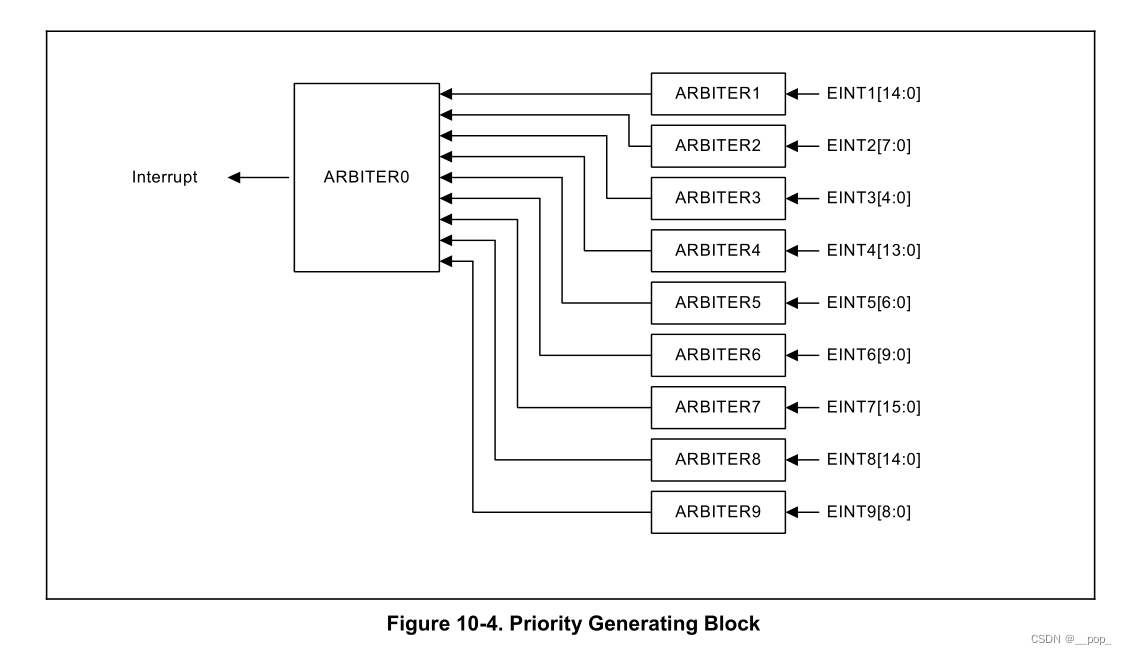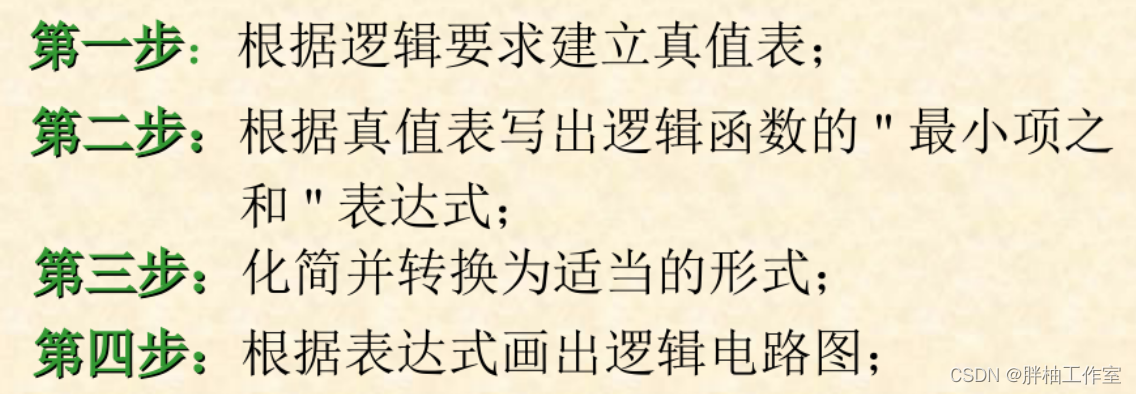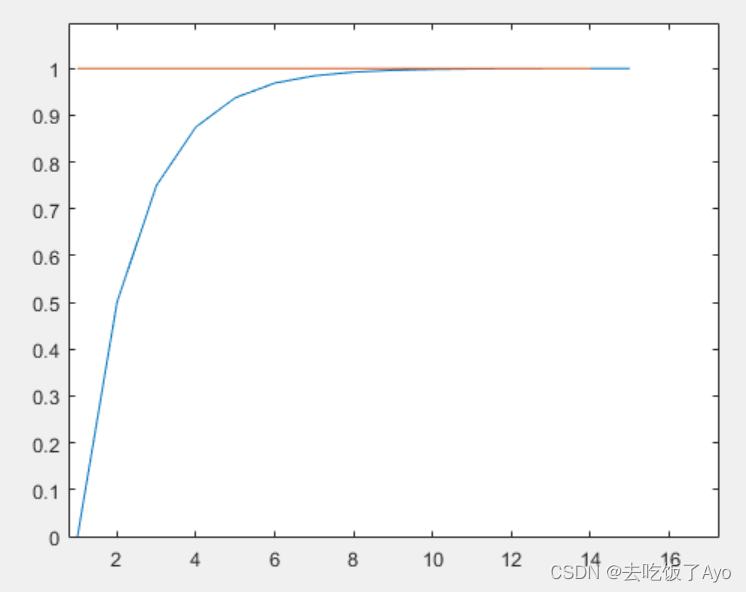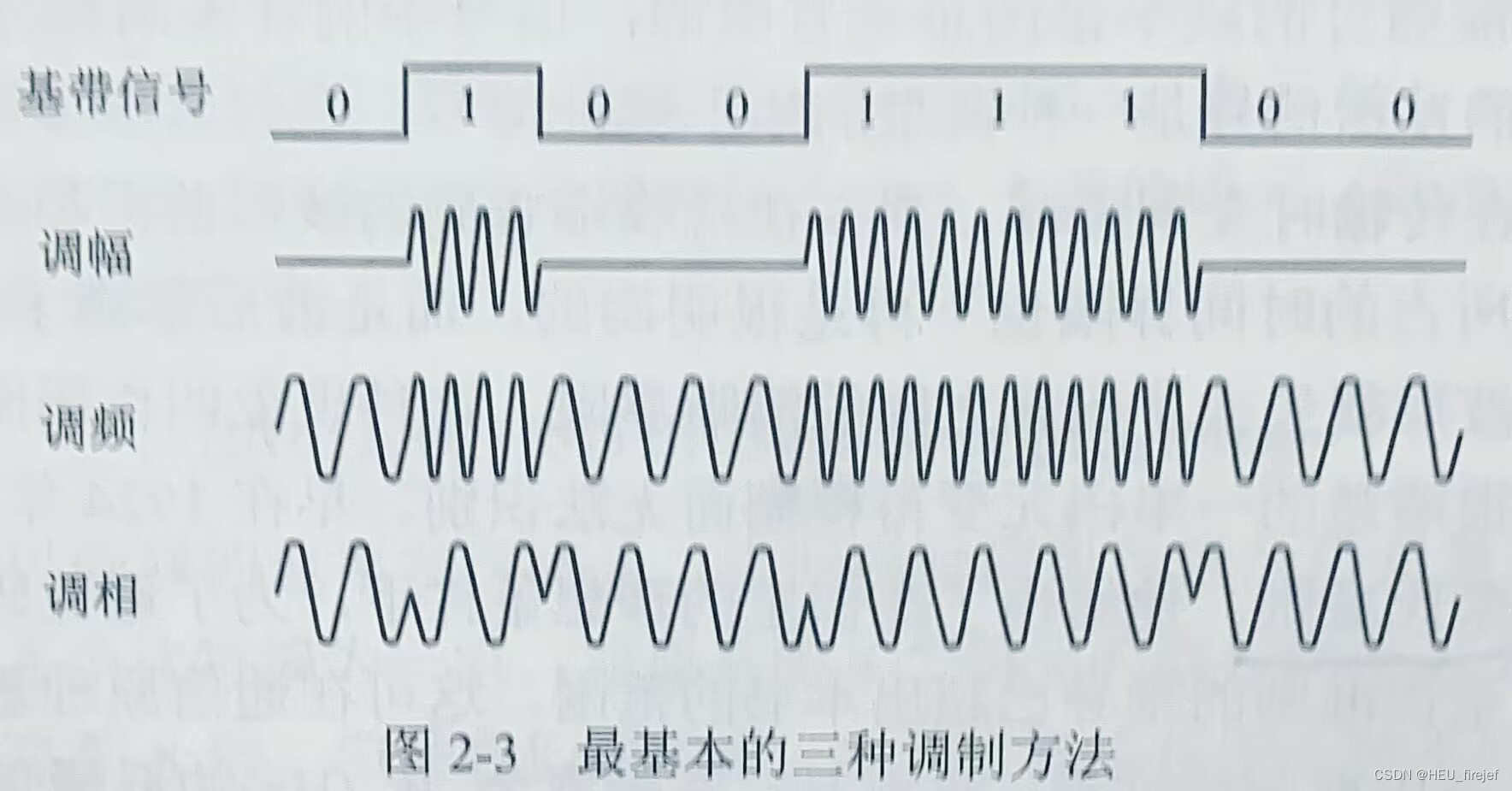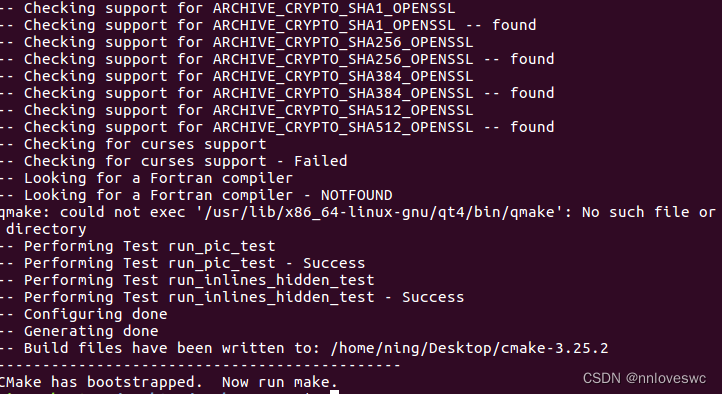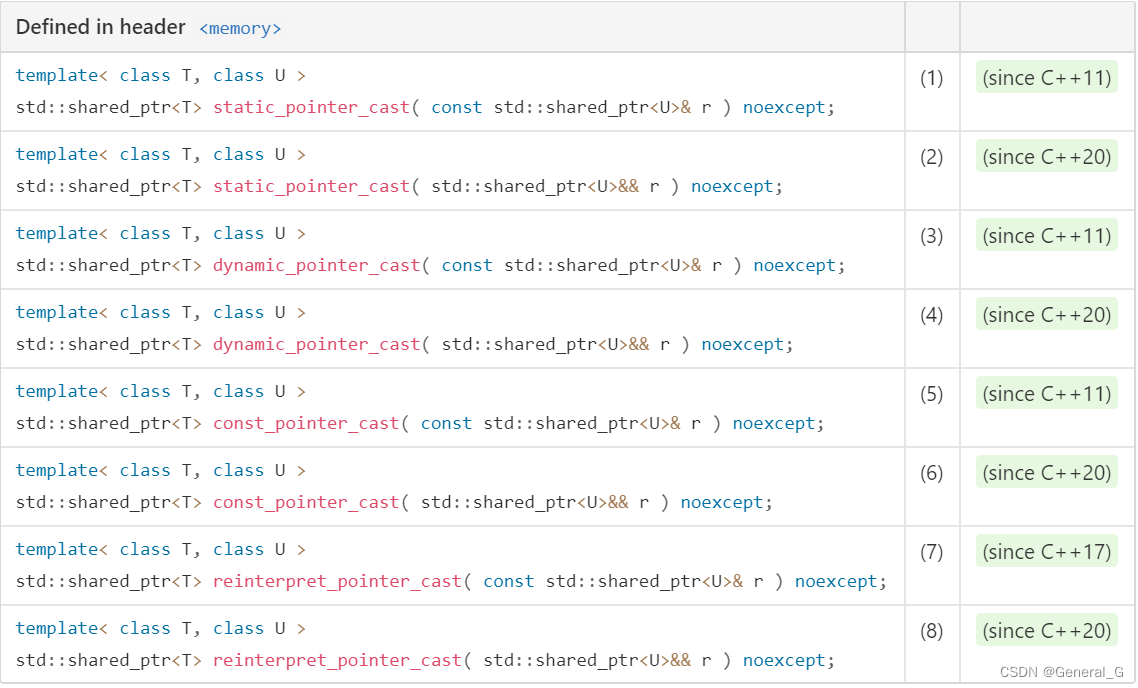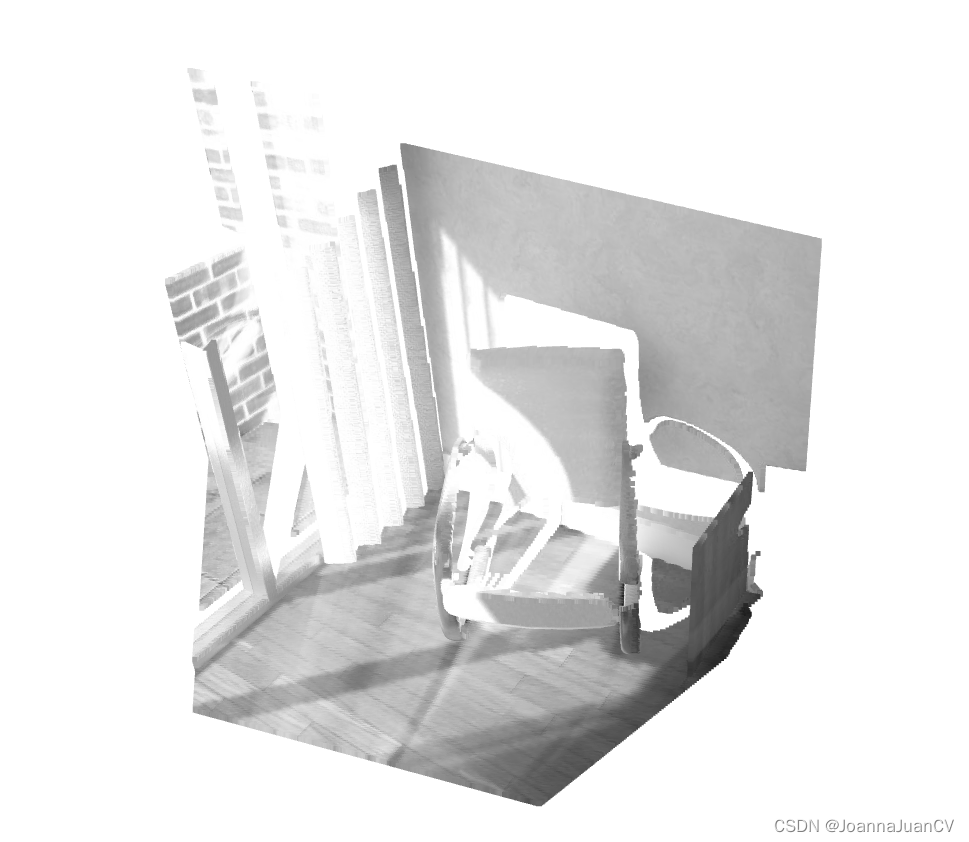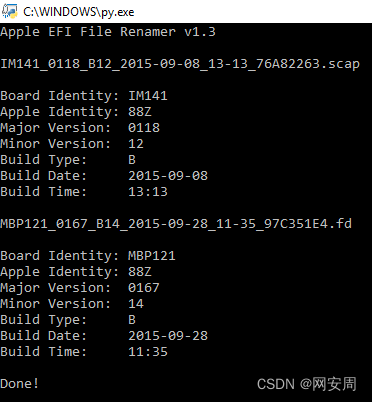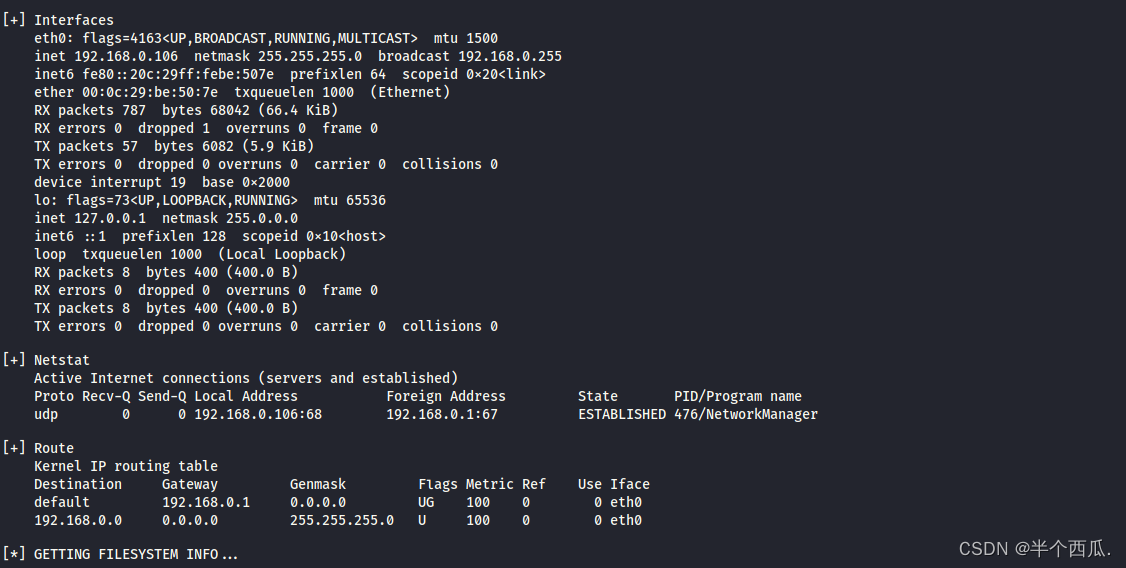HashMap超详细探讨
- 总述
- 从集合出发探讨HashMap
- Collection接口继承树
- Map接口继承树
- 从Map接口来,一步一步深入其中
- Map接口概述
- Map接口:常用方法
- Map接口
- Map实现类之一:HashMap
- HashMap的存储结构
- HashMap源码中的重要常量
- JDK 1.8之前
- JDK 1.8
- 总结:JDK1.8相较于之前的变化:
- 面试题:
- 深入分析 HashMap
- 一、传统 HashMap 的缺点
- 二、JDK1.8 中 HashMap 的数据结构
- 2.2HashMap 中关于红黑树的三个关键参数
- 2.3HashMap 在 JDK 1.8 中新增的操作:桶的树形化 treeifyBin()
- 三、分析 HashMap 的 put 方法
- 3.1HashMap 的 put 方法执行过程可以通过下图来理解,自己有兴趣可以去对比源码更清楚地研究学习。
- JDK1.8HashMap 的 put 方法源码
- HashMap源码
总述
阅读下面内容,可以帮助读者,快速了解HashMap的最为核心的知识。
HashMap是Java集合框架中的一种实现类,它提供了一种将键映射到值的数据结构。
HashMap继承自AbstractMap类,实现了Map接口,可以存储键值对,并且允许通过键来查找值,具有高效的查找和插入操作。
HashMap的实现是基于哈希表的,它通过哈希函数计算每个键的哈希码,并根据哈希码存储在哈希表的相应位置上。HashMap使用链表来解决哈希冲突,如果多个键映射到同一个位置,就会将它们放在同一个链表中。
下面是一些HashMap的详细信息:
- 构造函数:HashMap有多个构造函数,其中最常用的是不带参数的构造函数,它创建一个初始容量为16,负载因子为0.75的空HashMap。另外还有带初始容量和负载因子参数的构造函数。
- 负载因子:负载因子是指哈希表中的实际元素数量与哈希表容量的比率。当哈希表中的元素数量达到负载因子乘以容量时,哈希表会自动扩容。默认情况下,负载因子为0.75,这是一个经验值,可以在时间和空间之间进行权衡。
- 扩容:当哈希表中的元素数量达到负载因子乘以容量时,哈希表会自动扩容。扩容后,哈希表的容量将变为原来的两倍,并且所有的键值对将重新散列到新的位置上。
- put方法:put方法用于向HashMap中添加键值对,它接收两个参数,一个是键,一个是值。首先,它会计算键的哈希码,并根据哈希码找到键在哈希表中的位置。如果该位置已经有元素,那么就遍历链表,如果找到了相同的键,就用新的值替换旧的值。否则,就在链表的末尾添加一个新的节点。如果该位置没有元素,就创建一个新的节点,并将其放在该位置。
- get方法:get方法用于获取指定键的值,它接收一个参数,即要查找的键。首先,它会计算键的哈希码,并根据哈希码找到键在哈希表中的位置。然后,它遍历链表,找到与该键相同的节点,并返回节点的值。如果没有找到该键,就返回null。
- 遍历:HashMap提供了多种遍历方式,最常用的是使用迭代器遍历。可以通过keySet()、values()、entrySet()方法获得一个Set视图,然后通过该Set视图的迭代器进行遍历。例如,可以通过以下方式遍历HashMap中的所有键值对:
HashMap<String, Integer> map = new HashMap<>();
// 添加键值对
map.put("apple", 1);
map.put("banana", 2);
map.put("orange", 3);
// 获取keySet()视图并遍历
Set<String> keys = map.keySet();
for (String key : keys) {
System.out.println(key + " : " + map.get(key));
}
// 获取entrySet()视图并遍历
Set<Map.Entry<String, Integer>> entries = map.entrySet();
for (Map.Entry<String, Integer> entry : entries) {
System.out.println(entry.getKey() + " : " + entry.getValue());
}
- 并发:HashMap是非线程安全的,如果多个线程同时访问同一个HashMap实例,可能会导致数据不一致的问题。可以使用ConcurrentHashMap来解决这个问题,它是一个线程安全的HashMap实现。
- 避免哈希冲突:为了避免哈希冲突,可以在键对象的hashCode()方法中返回一个具有良好分布性的哈希码。另外,还可以在键对象的equals()方法中实现正确的相等比较,确保只有相同的键对象才会映射到同一个位置。
总的来说,HashMap是一个非常常用的集合类,它提供了高效的键值对存储和查找功能。但是需要注意的是,由于哈希表的实现,哈希冲突可能会影响HashMap的性能,因此需要注意键对象的哈希码计算和相等比较的实现。同时,在多线程环境下使用HashMap需要注意线程安全问题。
下面开始进入详细的探讨
从集合出发探讨HashMap

Collection接口继承树
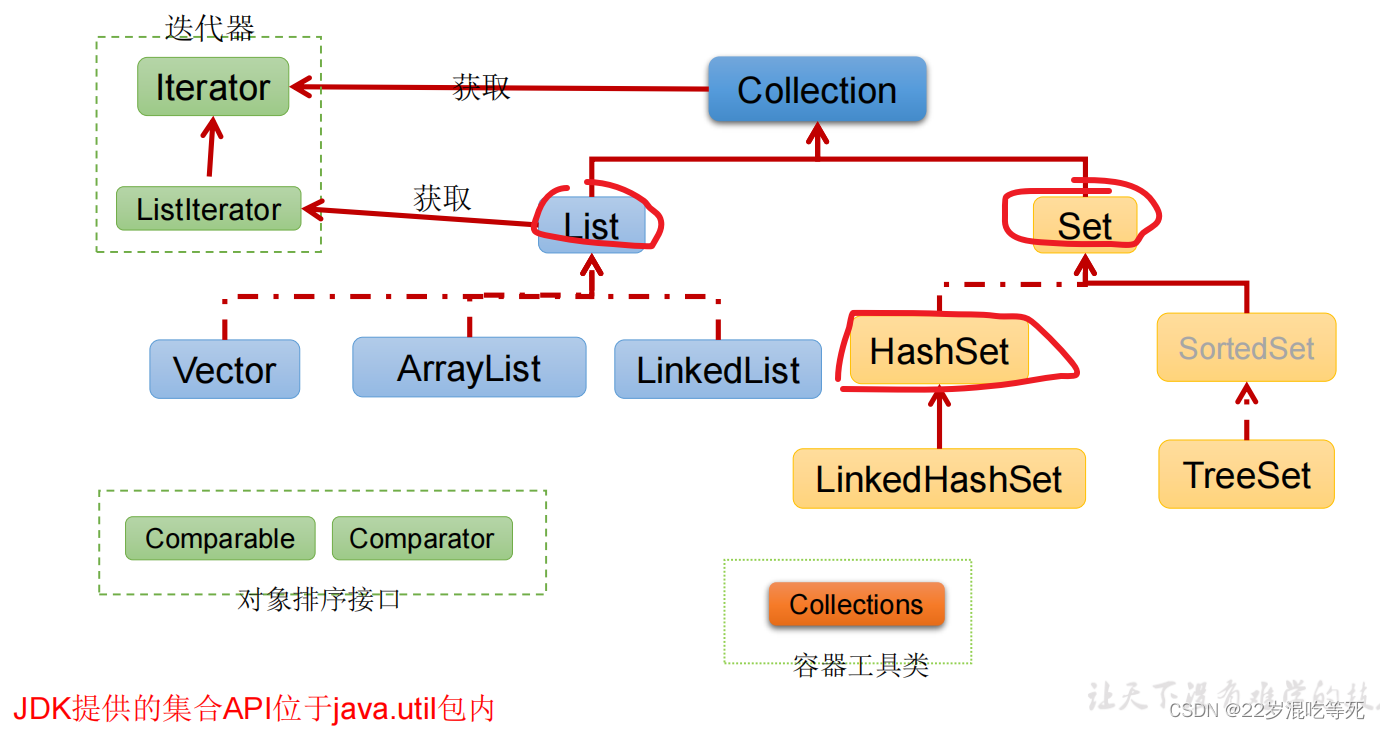
Map接口继承树
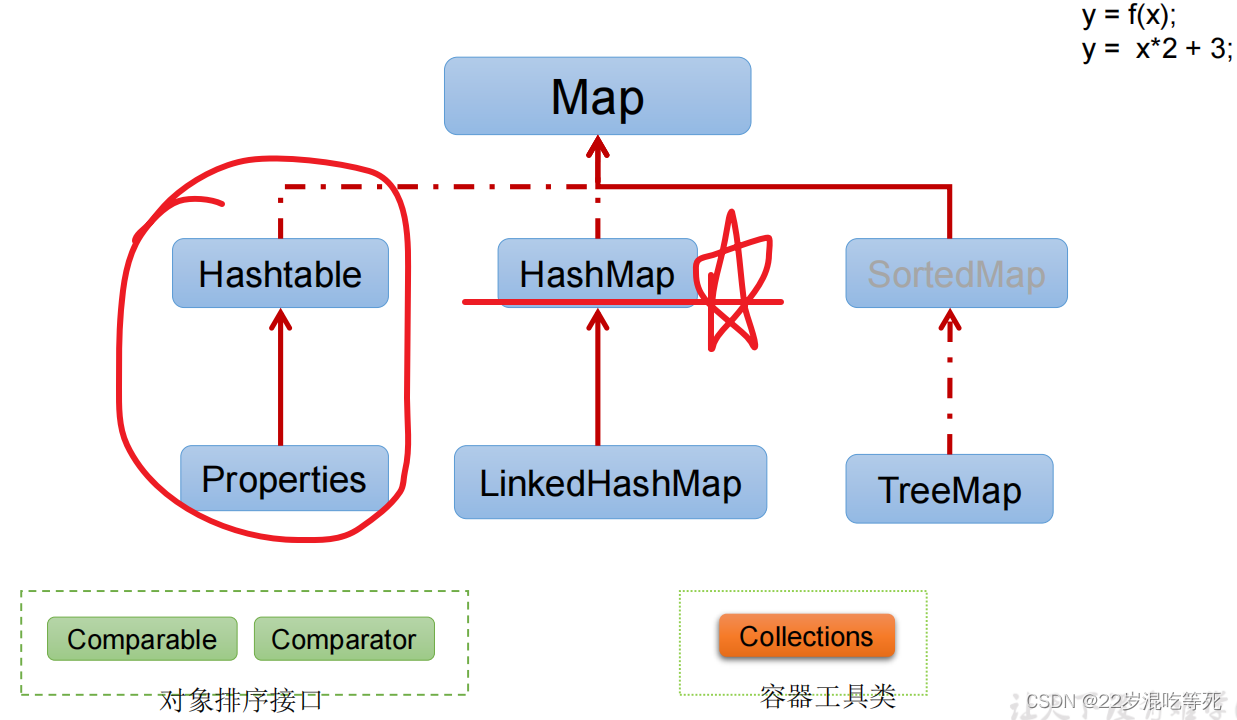
从Map接口来,一步一步深入其中

Map接口概述
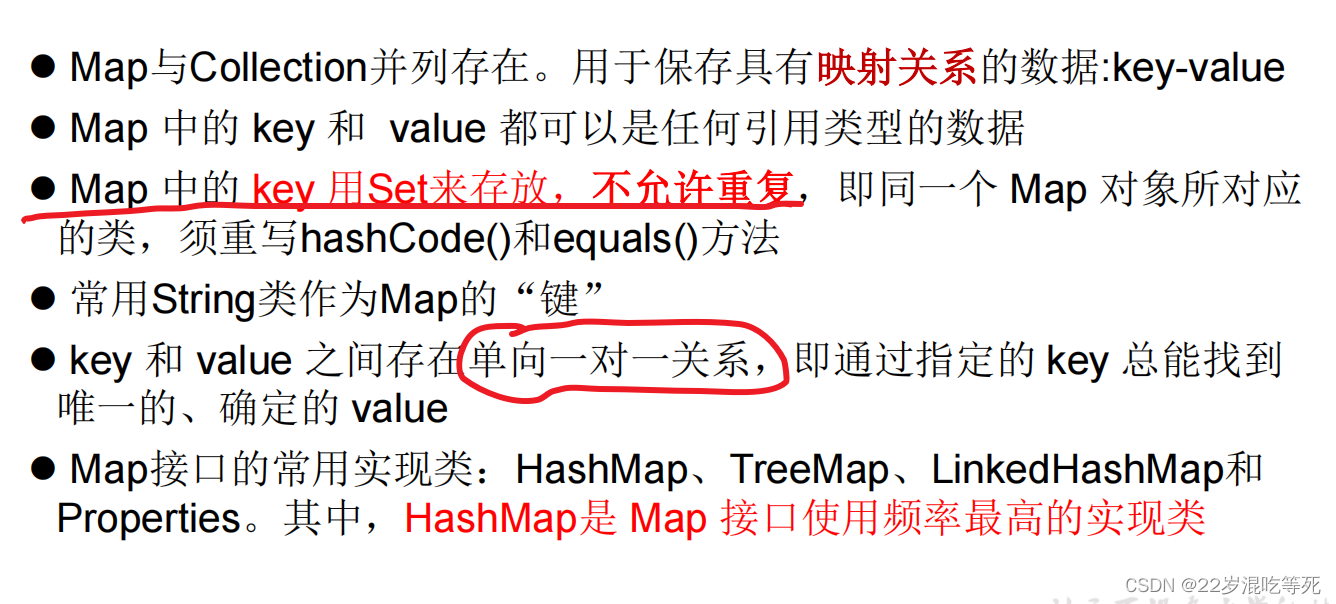
Map接口:常用方法
添加、删除、修改操作:
Object put(Object key,Object value):将指定key-value添加到(或修改)当前map对象中
void putAll(Map m):将m中的所有key-value对存放到当前map中
Object remove(Object key):移除指定key的key-value对,并返回value
void clear():清空当前map中的所有数据
元素查询的操作:
Object get(Object key):获取指定key对应的value
boolean containsKey(Object key):是否包含指定的key
boolean containsValue(Object value):是否包含指定的value
int size():返回map中key-value对的个数
boolean isEmpty():判断当前map是否为空
boolean equals(Object obj):判断当前map和参数对象obj是否相等
元视图操作的方法:
Set keySet():返回所有key构成的Set集合
Collection values():返回所有value构成的Collection集合
Set entrySet():返回所有key-value对构成的Set集合
Map接口
Map map = new HashMap();
//map.put(..,..)省略
System.out.println("map的所有key:");
Set keys = map.keySet();// HashSet
for (Object key : keys) {
System.out.println(key + "->" + map.get(key));
}
System.out.println("map的所有的value:");
Collection values = map.values();
Iterator iter = values.iterator();
while (iter.hasNext()) {
System.out.println(iter.next());
}
System.out.println("map所有的映射关系:");
// 映射关系的类型是Map.Entry类型,它是Map接口的内部接口
Set mappings = map.entrySet();
for (Object mapping : mappings) {
Map.Entry entry = (Map.Entry) mapping;
System.out.println("key是:" + entry.getKey() + ",value是:" + entry.getValue());
}
Map实现类之一:HashMap
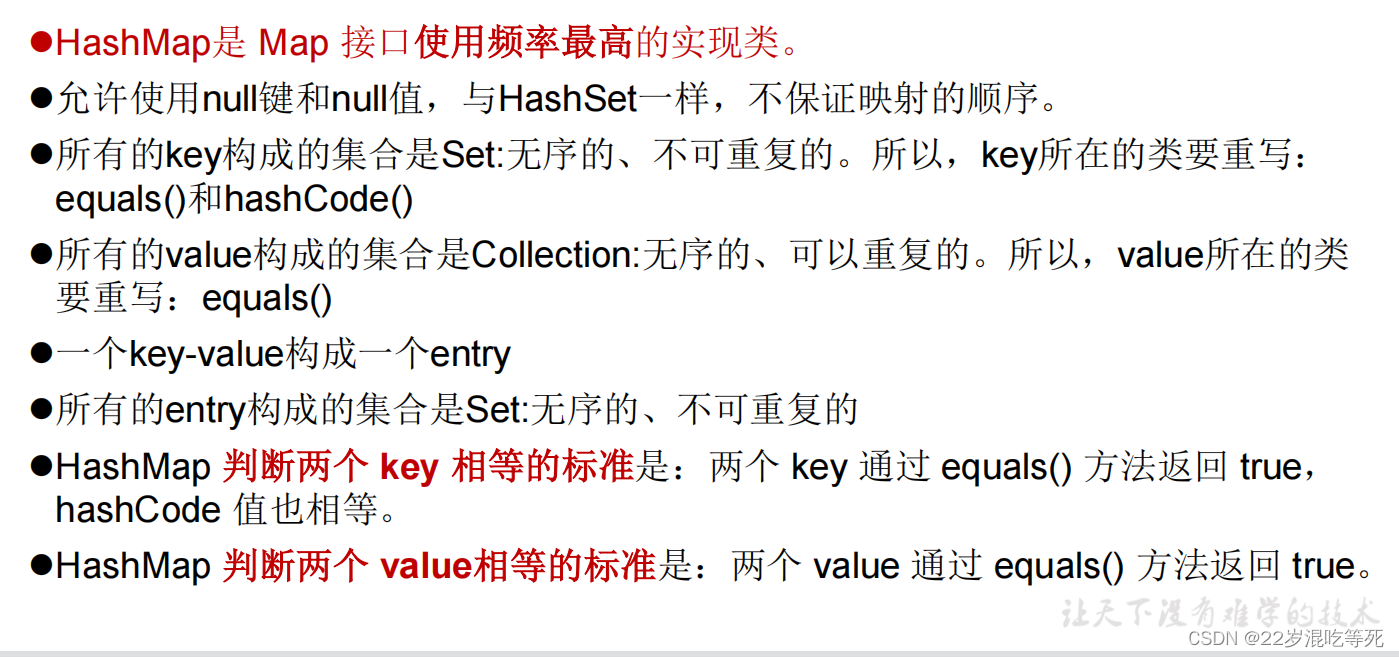
HashMap的存储结构
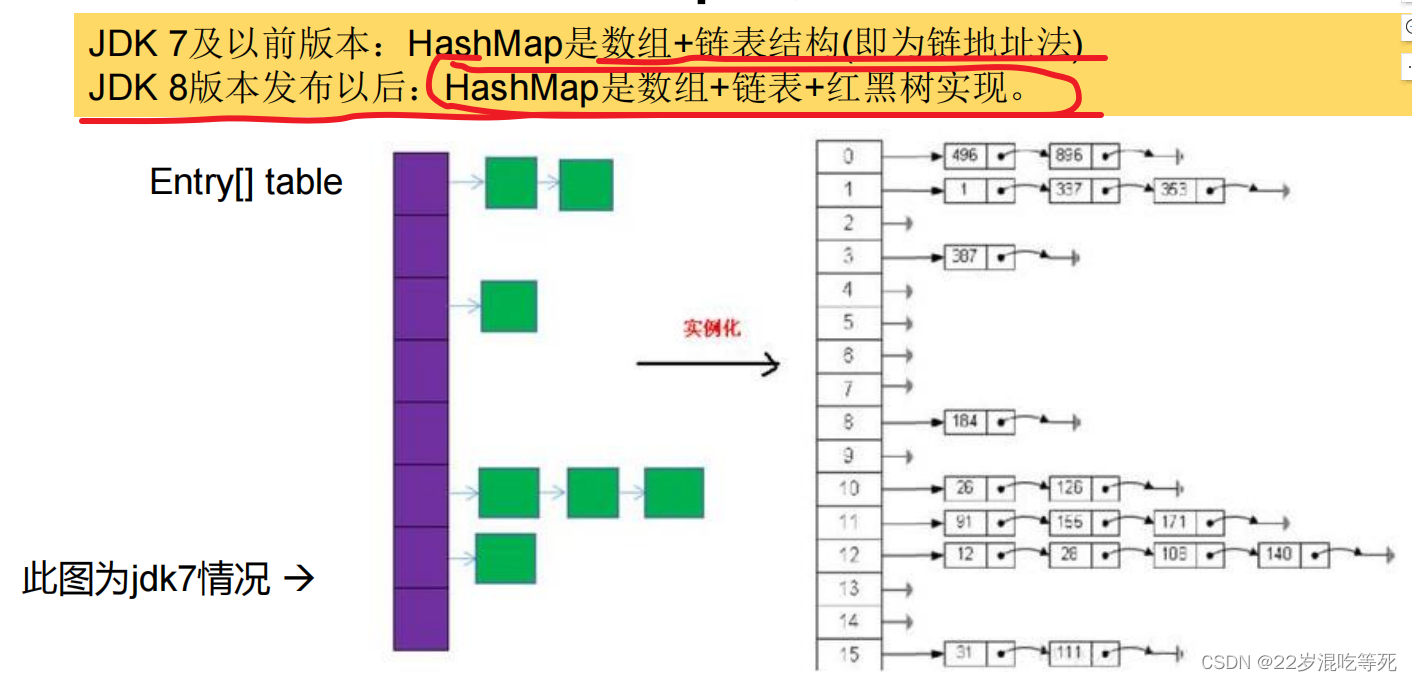
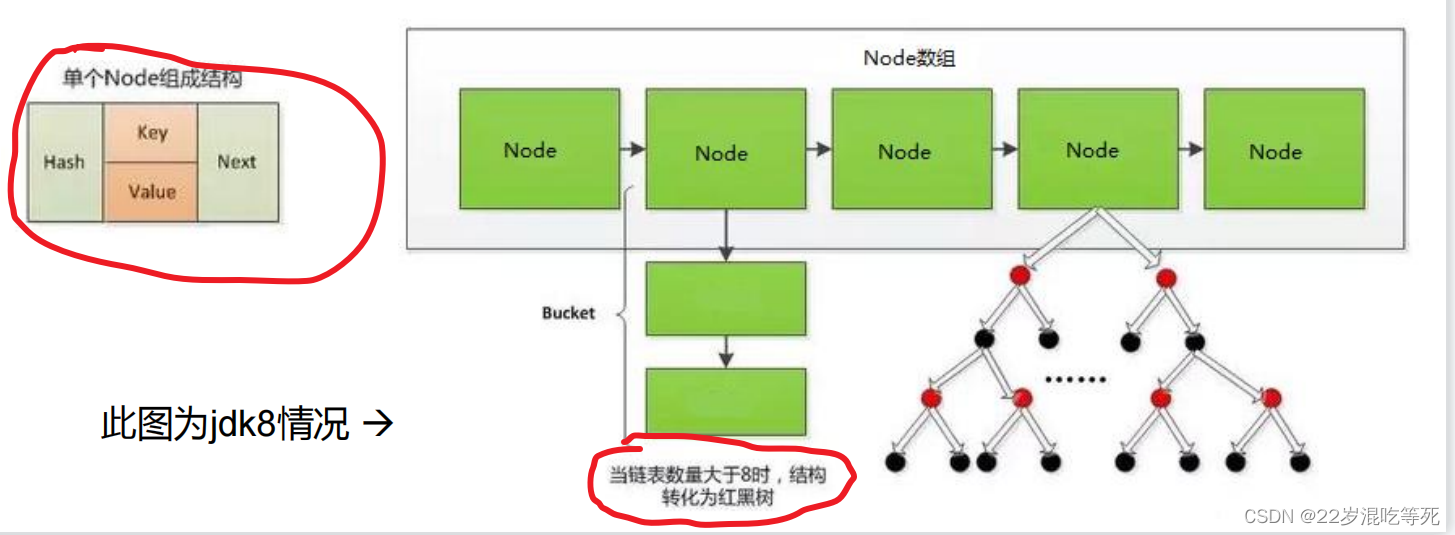
HashMap源码中的重要常量

JDK 1.8之前
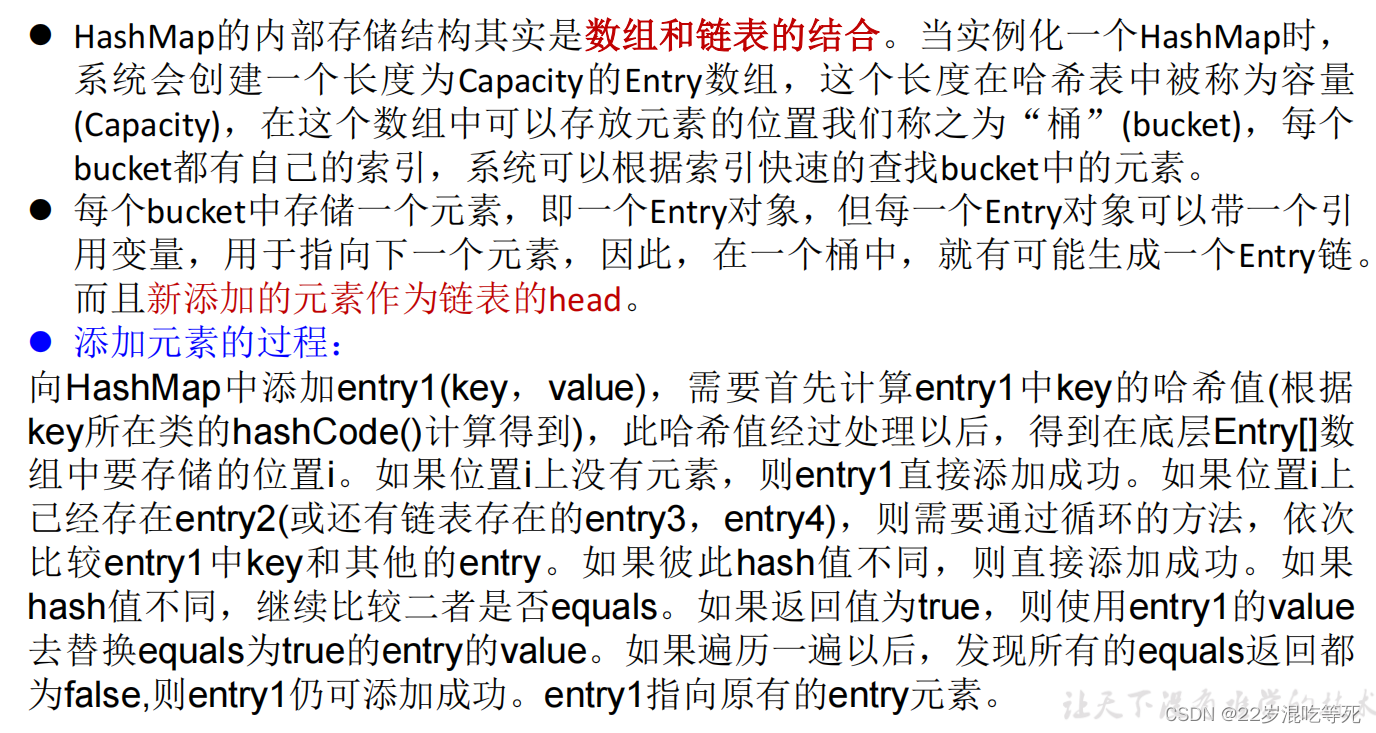

JDK 1.8
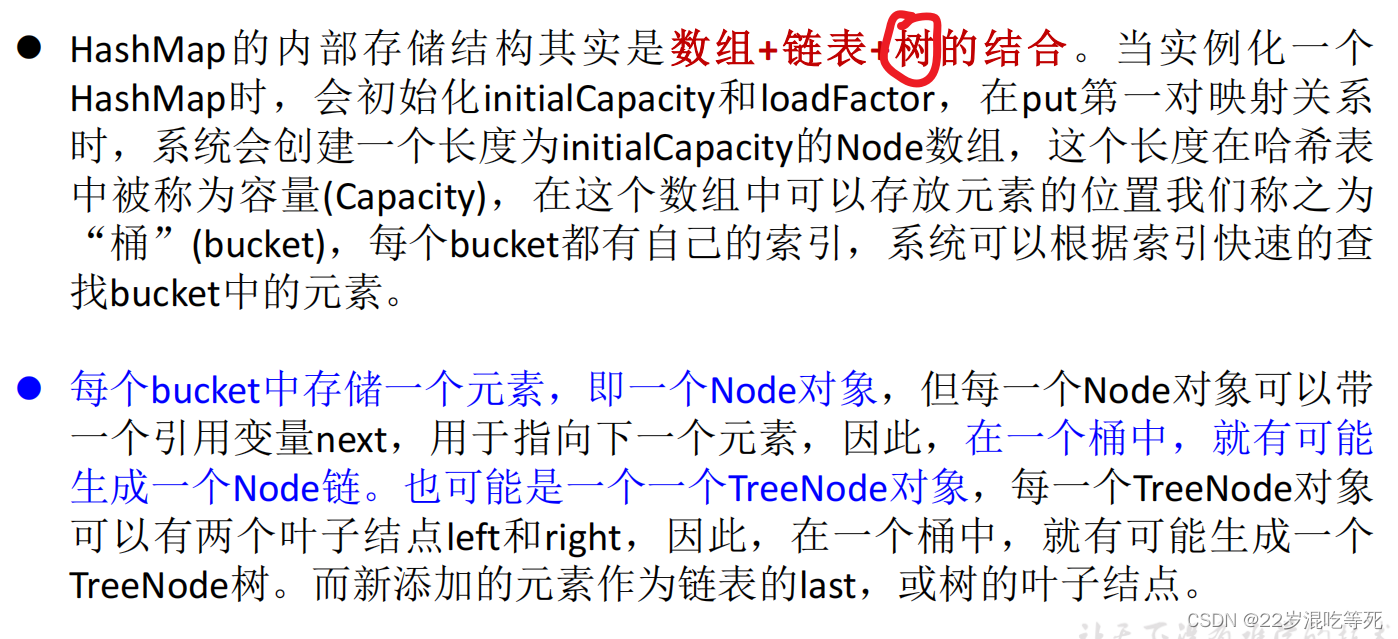
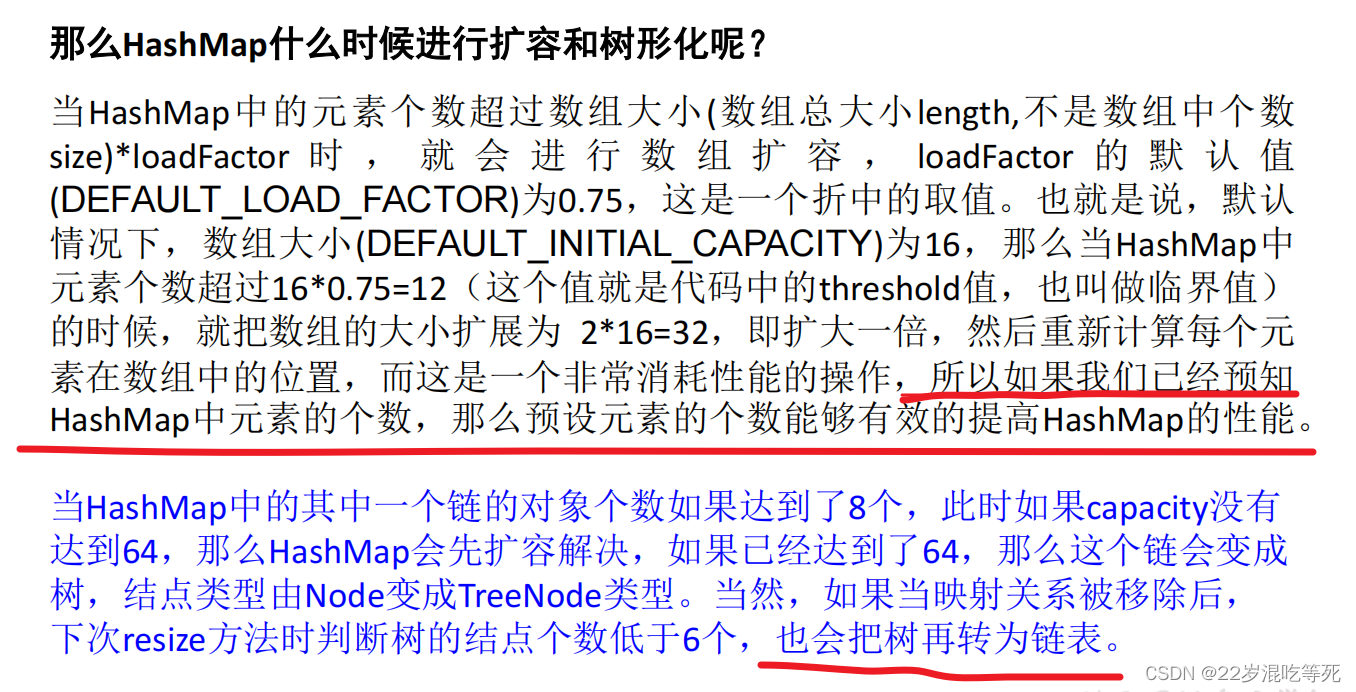

总结:JDK1.8相较于之前的变化:
1. HashMap map = new HashMap();//默认情况下,先不创建长度为16的数组
2. 当首次调用map.put()时,再创建长度为16的数组
3. 数组为Node类型,在jdk7中称为Entry类型
4. 形成链表结构时,新添加的key-value对在链表的尾部(七上八下)
5. 当数组指定索引位置的链表长度>8时,且map中的数组的长度> 64时,此索引位置
上的所有key-value对使用红黑树进行存储
面试题:
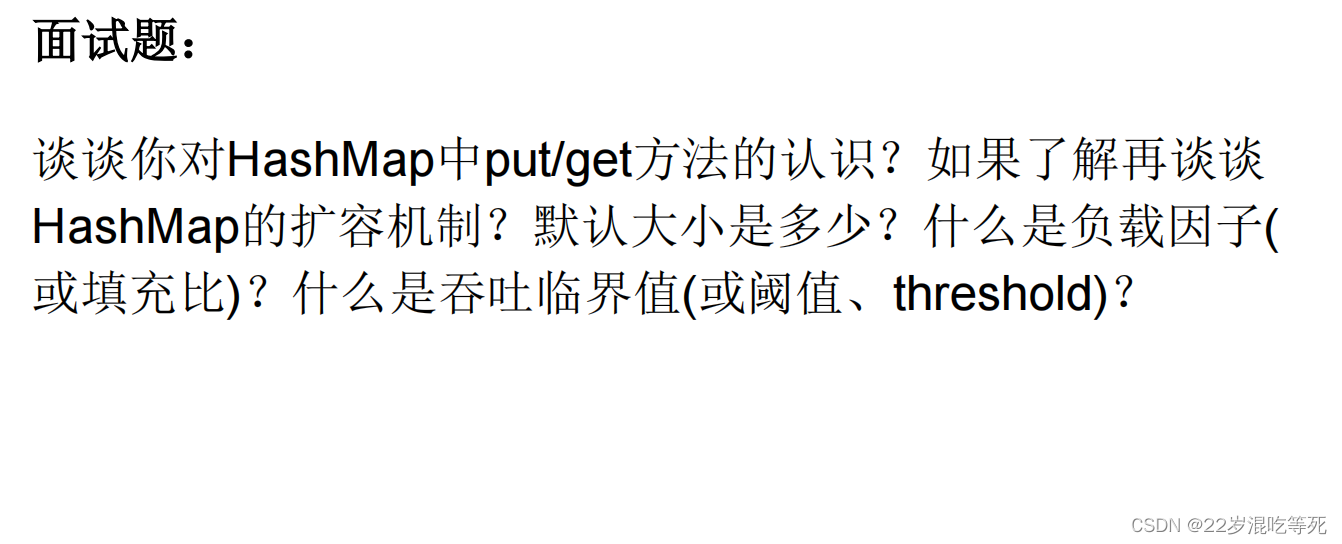
put(Object key,Object value):将指定key-value添加到(或修改)当前map对象中。
Object get(Object key):获取指定key对应的value
---------------------------------------------------------------------------------------------------------------------
当HashMap中的元素个数超过数组大小(数组总大小length,不是数组中个数size)loadFactor 时 , 就会进行数组扩容 , loadFactor 的默认值(DEFAULT_LOAD_FACTOR)为0.75,这是一个折中的取值。
也就是说,默认情况下,数组大小(DEFAULT_INITIAL_CAPACITY)为16,那么当HashMap中元素个数超过160.75=12(这个值就是代码中的threshold值,也叫做临界值)的时候,
就把数组的大小扩展为 2*16=32,即扩大一倍,然后重新计算每个元素在数组中的位置,
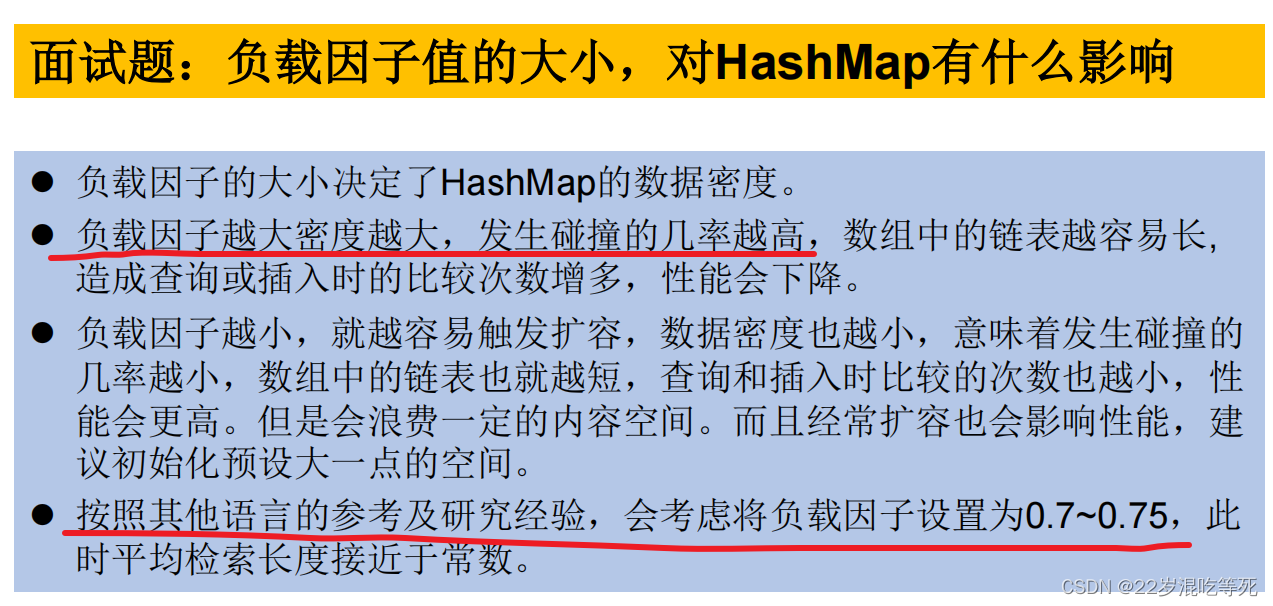
深入分析 HashMap
一、传统 HashMap 的缺点

二、JDK1.8 中 HashMap 的数据结构
2.1HashMap 是数组+链表+红黑树(JDK1.8 增加了红黑树部分)实现的
新增红黑树
static final class TreeNode<K,V> extends LinkedHashMap.Entry<K,V> {
TreeNode<K,V> parent; // red-black tree links
TreeNode<K,V> left;
TreeNode<K,V> right;
TreeNode<K,V> prev; // needed to unlink next upon deletion
boolean red;
}
2.2HashMap 中关于红黑树的三个关键参数
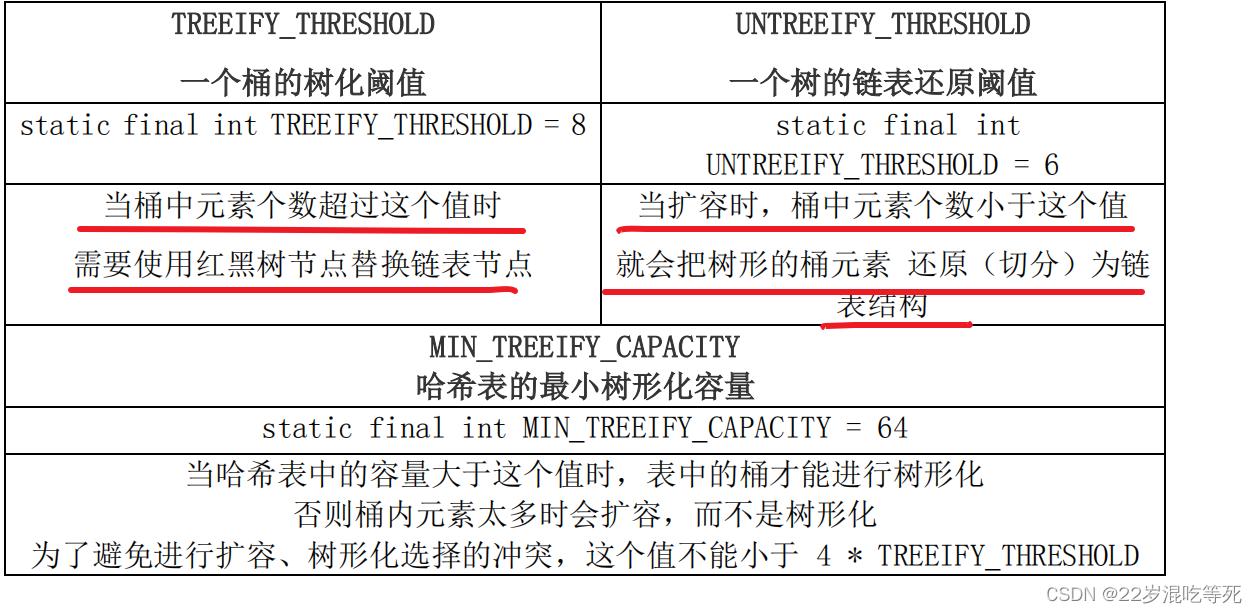
2.3HashMap 在 JDK 1.8 中新增的操作:桶的树形化 treeifyBin()
在 Java 8 中,如果一个桶中的元素个数超过 TREEIFY_THRESHOLD(默认是 8 ),就使用红黑树来替换链表,从而提高速度。
这个替换的方法叫 treeifyBin() 即树形化。
//将桶内所有的 链表节点 替换成 红黑树节点
1 final void treeifyBin(Node<K,V>[] tab, int hash) {
2 int n, index; Node<K,V> e;
3 //如果当前哈希表为空,或者哈希表中元素的个数小于 进行树形化的阈值(默认为 64),就去新建/扩容
4 if (tab == null || (n = tab.length) < MIN_TREEIFY_CAPACITY)
5 resize();
6 else if ((e = tab[index = (n - 1) & hash]) != null) {
7 //如果哈希表中的元素个数超过了 树形化阈值,进行树形化
8 // e 是哈希表中指定位置桶里的链表节点,从第一个开始
9 TreeNode<K,V> hd = null, tl = null; //红黑树的头、尾节点
10 do {
11 //新建一个树形节点,内容和当前链表节点 e 一致
12 TreeNode<K,V> p = replacementTreeNode(e, null);
13 if (tl == null) //确定树头节点
14 hd = p;
15 else {
16 p.prev = tl;
17 tl.next = p;
18 }
19 tl = p;
20 } while ((e = e.next) != null);
21 //让桶的第一个元素指向新建的红黑树头结点,以后这个桶里的元素就是红黑树而不是链表了
22 if ((tab[index] = hd) != null)
23 hd.treeify(tab);
24 }
25 }
26 TreeNode<K,V> replacementTreeNode(Node<K,V> p, Node<K,V> next) {
27 return new TreeNode<>(p.hash, p.key, p.value, next);
28 }

三、分析 HashMap 的 put 方法
3.1HashMap 的 put 方法执行过程可以通过下图来理解,自己有兴趣可以去对比源码更清楚地研究学习。
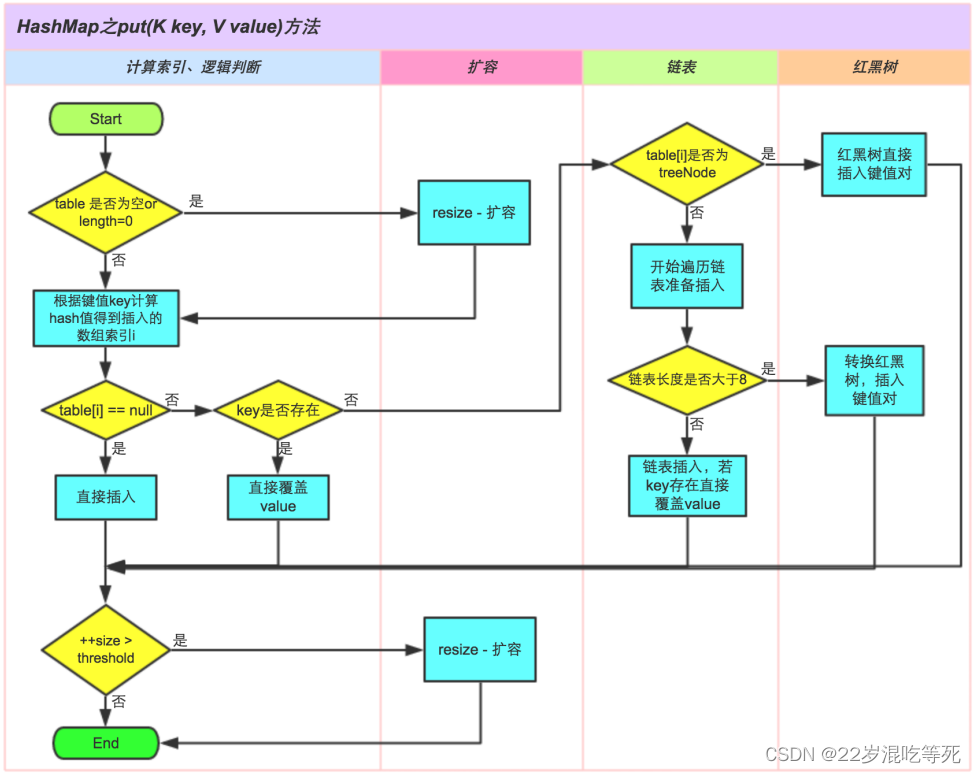
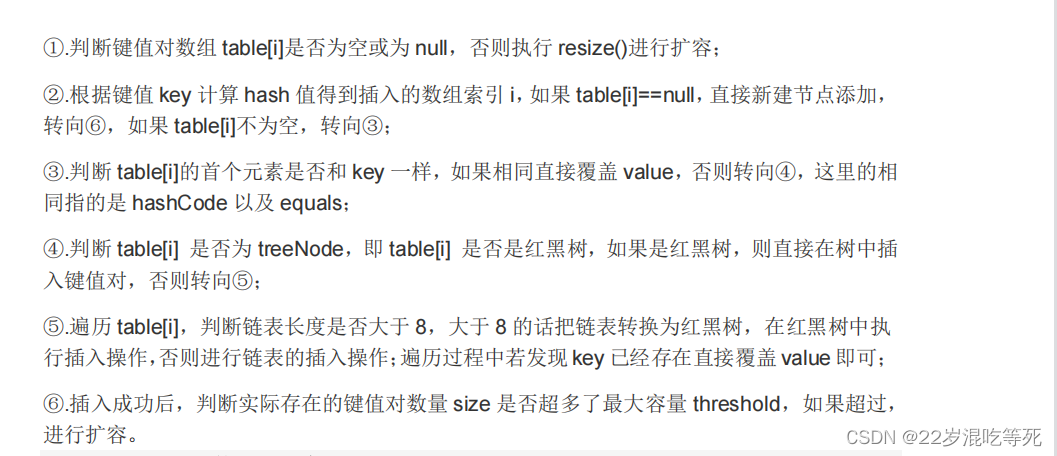
JDK1.8HashMap 的 put 方法源码
final V putVal(int hash, K key, V value, boolean onlyIfAbsent,
boolean evict) {
Node<K,V>[] tab; Node<K,V> p; int n, i;
if ((tab = table) == null || (n = tab.length) == 0)
n = (tab = resize()).length;
if ((p = tab[i = (n - 1) & hash]) == null)
tab[i] = newNode(hash, key, value, null);
else {
Node<K,V> e; K k;
if (p.hash == hash &&
((k = p.key) == key || (key != null && key.equals(k))))
e = p;
else if (p instanceof TreeNode)
e = ((TreeNode<K,V>)p).putTreeVal(this, tab, hash, key, value);
else {
for (int binCount = 0; ; ++binCount) {
if ((e = p.next) == null) {
p.next = newNode(hash, key, value, null);
if (binCount >= TREEIFY_THRESHOLD - 1) // -1 for 1st
treeifyBin(tab, hash);
break;
}
if (e.hash == hash &&
((k = e.key) == key || (key != null && key.equals(k))))
break;
p = e;
}
}
if (e != null) { // existing mapping for key
V oldValue = e.value;
if (!onlyIfAbsent || oldValue == null)
e.value = value;
afterNodeAccess(e);
return oldValue;
}
}
++modCount;
if (++size > threshold)
resize();
afterNodeInsertion(evict);
return null;
}
HashMap源码
/*
* Copyright (c) 1997, 2021, Oracle and/or its affiliates. All rights reserved.
* ORACLE PROPRIETARY/CONFIDENTIAL. Use is subject to license terms.
*
*
*
*
*
*
*
*
*
*
*
*
*
*
*
*
*
*
*
*
*/
package java.util;
import java.io.IOException;
import java.io.InvalidObjectException;
import java.io.ObjectInputStream;
import java.io.Serializable;
import java.lang.reflect.ParameterizedType;
import java.lang.reflect.Type;
import java.util.function.BiConsumer;
import java.util.function.BiFunction;
import java.util.function.Consumer;
import java.util.function.Function;
import sun.misc.SharedSecrets;
/**
* Hash table based implementation of the <tt>Map</tt> interface. This
* implementation provides all of the optional map operations, and permits
* <tt>null</tt> values and the <tt>null</tt> key. (The <tt>HashMap</tt>
* class is roughly equivalent to <tt>Hashtable</tt>, except that it is
* unsynchronized and permits nulls.) This class makes no guarantees as to
* the order of the map; in particular, it does not guarantee that the order
* will remain constant over time.
*
* <p>This implementation provides constant-time performance for the basic
* operations (<tt>get</tt> and <tt>put</tt>), assuming the hash function
* disperses the elements properly among the buckets. Iteration over
* collection views requires time proportional to the "capacity" of the
* <tt>HashMap</tt> instance (the number of buckets) plus its size (the number
* of key-value mappings). Thus, it's very important not to set the initial
* capacity too high (or the load factor too low) if iteration performance is
* important.
*
* <p>An instance of <tt>HashMap</tt> has two parameters that affect its
* performance: <i>initial capacity</i> and <i>load factor</i>. The
* <i>capacity</i> is the number of buckets in the hash table, and the initial
* capacity is simply the capacity at the time the hash table is created. The
* <i>load factor</i> is a measure of how full the hash table is allowed to
* get before its capacity is automatically increased. When the number of
* entries in the hash table exceeds the product of the load factor and the
* current capacity, the hash table is <i>rehashed</i> (that is, internal data
* structures are rebuilt) so that the hash table has approximately twice the
* number of buckets.
*
* <p>As a general rule, the default load factor (.75) offers a good
* tradeoff between time and space costs. Higher values decrease the
* space overhead but increase the lookup cost (reflected in most of
* the operations of the <tt>HashMap</tt> class, including
* <tt>get</tt> and <tt>put</tt>). The expected number of entries in
* the map and its load factor should be taken into account when
* setting its initial capacity, so as to minimize the number of
* rehash operations. If the initial capacity is greater than the
* maximum number of entries divided by the load factor, no rehash
* operations will ever occur.
*
* <p>If many mappings are to be stored in a <tt>HashMap</tt>
* instance, creating it with a sufficiently large capacity will allow
* the mappings to be stored more efficiently than letting it perform
* automatic rehashing as needed to grow the table. Note that using
* many keys with the same {@code hashCode()} is a sure way to slow
* down performance of any hash table. To ameliorate impact, when keys
* are {@link Comparable}, this class may use comparison order among
* keys to help break ties.
*
* <p><strong>Note that this implementation is not synchronized.</strong>
* If multiple threads access a hash map concurrently, and at least one of
* the threads modifies the map structurally, it <i>must</i> be
* synchronized externally. (A structural modification is any operation
* that adds or deletes one or more mappings; merely changing the value
* associated with a key that an instance already contains is not a
* structural modification.) This is typically accomplished by
* synchronizing on some object that naturally encapsulates the map.
*
* If no such object exists, the map should be "wrapped" using the
* {@link Collections#synchronizedMap Collections.synchronizedMap}
* method. This is best done at creation time, to prevent accidental
* unsynchronized access to the map:<pre>
* Map m = Collections.synchronizedMap(new HashMap(...));</pre>
*
* <p>The iterators returned by all of this class's "collection view methods"
* are <i>fail-fast</i>: if the map is structurally modified at any time after
* the iterator is created, in any way except through the iterator's own
* <tt>remove</tt> method, the iterator will throw a
* {@link ConcurrentModificationException}. Thus, in the face of concurrent
* modification, the iterator fails quickly and cleanly, rather than risking
* arbitrary, non-deterministic behavior at an undetermined time in the
* future.
*
* <p>Note that the fail-fast behavior of an iterator cannot be guaranteed
* as it is, generally speaking, impossible to make any hard guarantees in the
* presence of unsynchronized concurrent modification. Fail-fast iterators
* throw <tt>ConcurrentModificationException</tt> on a best-effort basis.
* Therefore, it would be wrong to write a program that depended on this
* exception for its correctness: <i>the fail-fast behavior of iterators
* should be used only to detect bugs.</i>
*
* <p>This class is a member of the
* <a href="{@docRoot}/../technotes/guides/collections/index.html">
* Java Collections Framework</a>.
*
* @param <K> the type of keys maintained by this map
* @param <V> the type of mapped values
*
* @author Doug Lea
* @author Josh Bloch
* @author Arthur van Hoff
* @author Neal Gafter
* @see Object#hashCode()
* @see Collection
* @see Map
* @see TreeMap
* @see Hashtable
* @since 1.2
*/
public class HashMap<K,V> extends AbstractMap<K,V>
implements Map<K,V>, Cloneable, Serializable {
private static final long serialVersionUID = 362498820763181265L;
/*
* Implementation notes.
*
* This map usually acts as a binned (bucketed) hash table, but
* when bins get too large, they are transformed into bins of
* TreeNodes, each structured similarly to those in
* java.util.TreeMap. Most methods try to use normal bins, but
* relay to TreeNode methods when applicable (simply by checking
* instanceof a node). Bins of TreeNodes may be traversed and
* used like any others, but additionally support faster lookup
* when overpopulated. However, since the vast majority of bins in
* normal use are not overpopulated, checking for existence of
* tree bins may be delayed in the course of table methods.
*
* Tree bins (i.e., bins whose elements are all TreeNodes) are
* ordered primarily by hashCode, but in the case of ties, if two
* elements are of the same "class C implements Comparable<C>",
* type then their compareTo method is used for ordering. (We
* conservatively check generic types via reflection to validate
* this -- see method comparableClassFor). The added complexity
* of tree bins is worthwhile in providing worst-case O(log n)
* operations when keys either have distinct hashes or are
* orderable, Thus, performance degrades gracefully under
* accidental or malicious usages in which hashCode() methods
* return values that are poorly distributed, as well as those in
* which many keys share a hashCode, so long as they are also
* Comparable. (If neither of these apply, we may waste about a
* factor of two in time and space compared to taking no
* precautions. But the only known cases stem from poor user
* programming practices that are already so slow that this makes
* little difference.)
*
* Because TreeNodes are about twice the size of regular nodes, we
* use them only when bins contain enough nodes to warrant use
* (see TREEIFY_THRESHOLD). And when they become too small (due to
* removal or resizing) they are converted back to plain bins. In
* usages with well-distributed user hashCodes, tree bins are
* rarely used. Ideally, under random hashCodes, the frequency of
* nodes in bins follows a Poisson distribution
* (http://en.wikipedia.org/wiki/Poisson_distribution) with a
* parameter of about 0.5 on average for the default resizing
* threshold of 0.75, although with a large variance because of
* resizing granularity. Ignoring variance, the expected
* occurrences of list size k are (exp(-0.5) * pow(0.5, k) /
* factorial(k)). The first values are:
*
* 0: 0.60653066
* 1: 0.30326533
* 2: 0.07581633
* 3: 0.01263606
* 4: 0.00157952
* 5: 0.00015795
* 6: 0.00001316
* 7: 0.00000094
* 8: 0.00000006
* more: less than 1 in ten million
*
* The root of a tree bin is normally its first node. However,
* sometimes (currently only upon Iterator.remove), the root might
* be elsewhere, but can be recovered following parent links
* (method TreeNode.root()).
*
* All applicable internal methods accept a hash code as an
* argument (as normally supplied from a public method), allowing
* them to call each other without recomputing user hashCodes.
* Most internal methods also accept a "tab" argument, that is
* normally the current table, but may be a new or old one when
* resizing or converting.
*
* When bin lists are treeified, split, or untreeified, we keep
* them in the same relative access/traversal order (i.e., field
* Node.next) to better preserve locality, and to slightly
* simplify handling of splits and traversals that invoke
* iterator.remove. When using comparators on insertion, to keep a
* total ordering (or as close as is required here) across
* rebalancings, we compare classes and identityHashCodes as
* tie-breakers.
*
* The use and transitions among plain vs tree modes is
* complicated by the existence of subclass LinkedHashMap. See
* below for hook methods defined to be invoked upon insertion,
* removal and access that allow LinkedHashMap internals to
* otherwise remain independent of these mechanics. (This also
* requires that a map instance be passed to some utility methods
* that may create new nodes.)
*
* The concurrent-programming-like SSA-based coding style helps
* avoid aliasing errors amid all of the twisty pointer operations.
*/
/**
* The default initial capacity - MUST be a power of two.
*/
static final int DEFAULT_INITIAL_CAPACITY = 1 << 4; // aka 16
/**
* The maximum capacity, used if a higher value is implicitly specified
* by either of the constructors with arguments.
* MUST be a power of two <= 1<<30.
*/
static final int MAXIMUM_CAPACITY = 1 << 30;
/**
* The load factor used when none specified in constructor.
*/
static final float DEFAULT_LOAD_FACTOR = 0.75f;
/**
* The bin count threshold for using a tree rather than list for a
* bin. Bins are converted to trees when adding an element to a
* bin with at least this many nodes. The value must be greater
* than 2 and should be at least 8 to mesh with assumptions in
* tree removal about conversion back to plain bins upon
* shrinkage.
*/
static final int TREEIFY_THRESHOLD = 8;
/**
* The bin count threshold for untreeifying a (split) bin during a
* resize operation. Should be less than TREEIFY_THRESHOLD, and at
* most 6 to mesh with shrinkage detection under removal.
*/
static final int UNTREEIFY_THRESHOLD = 6;
/**
* The smallest table capacity for which bins may be treeified.
* (Otherwise the table is resized if too many nodes in a bin.)
* Should be at least 4 * TREEIFY_THRESHOLD to avoid conflicts
* between resizing and treeification thresholds.
*/
static final int MIN_TREEIFY_CAPACITY = 64;
/**
* Basic hash bin node, used for most entries. (See below for
* TreeNode subclass, and in LinkedHashMap for its Entry subclass.)
*/
static class Node<K,V> implements Map.Entry<K,V> {
final int hash;
final K key;
V value;
Node<K,V> next;
Node(int hash, K key, V value, Node<K,V> next) {
this.hash = hash;
this.key = key;
this.value = value;
this.next = next;
}
public final K getKey() { return key; }
public final V getValue() { return value; }
public final String toString() { return key + "=" + value; }
public final int hashCode() {
return Objects.hashCode(key) ^ Objects.hashCode(value);
}
public final V setValue(V newValue) {
V oldValue = value;
value = newValue;
return oldValue;
}
public final boolean equals(Object o) {
if (o == this)
return true;
if (o instanceof Map.Entry) {
Map.Entry<?,?> e = (Map.Entry<?,?>)o;
if (Objects.equals(key, e.getKey()) &&
Objects.equals(value, e.getValue()))
return true;
}
return false;
}
}
/* ---------------- Static utilities -------------- */
/**
* Computes key.hashCode() and spreads (XORs) higher bits of hash
* to lower. Because the table uses power-of-two masking, sets of
* hashes that vary only in bits above the current mask will
* always collide. (Among known examples are sets of Float keys
* holding consecutive whole numbers in small tables.) So we
* apply a transform that spreads the impact of higher bits
* downward. There is a tradeoff between speed, utility, and
* quality of bit-spreading. Because many common sets of hashes
* are already reasonably distributed (so don't benefit from
* spreading), and because we use trees to handle large sets of
* collisions in bins, we just XOR some shifted bits in the
* cheapest possible way to reduce systematic lossage, as well as
* to incorporate impact of the highest bits that would otherwise
* never be used in index calculations because of table bounds.
*/
static final int hash(Object key) {
int h;
return (key == null) ? 0 : (h = key.hashCode()) ^ (h >>> 16);
}
/**
* Returns x's Class if it is of the form "class C implements
* Comparable<C>", else null.
*/
static Class<?> comparableClassFor(Object x) {
if (x instanceof Comparable) {
Class<?> c; Type[] ts, as; Type t; ParameterizedType p;
if ((c = x.getClass()) == String.class) // bypass checks
return c;
if ((ts = c.getGenericInterfaces()) != null) {
for (int i = 0; i < ts.length; ++i) {
if (((t = ts[i]) instanceof ParameterizedType) &&
((p = (ParameterizedType)t).getRawType() ==
Comparable.class) &&
(as = p.getActualTypeArguments()) != null &&
as.length == 1 && as[0] == c) // type arg is c
return c;
}
}
}
return null;
}
/**
* Returns k.compareTo(x) if x matches kc (k's screened comparable
* class), else 0.
*/
@SuppressWarnings({"rawtypes","unchecked"}) // for cast to Comparable
static int compareComparables(Class<?> kc, Object k, Object x) {
return (x == null || x.getClass() != kc ? 0 :
((Comparable)k).compareTo(x));
}
/**
* Returns a power of two size for the given target capacity.
*/
static final int tableSizeFor(int cap) {
int n = cap - 1;
n |= n >>> 1;
n |= n >>> 2;
n |= n >>> 4;
n |= n >>> 8;
n |= n >>> 16;
return (n < 0) ? 1 : (n >= MAXIMUM_CAPACITY) ? MAXIMUM_CAPACITY : n + 1;
}
/* ---------------- Fields -------------- */
/**
* The table, initialized on first use, and resized as
* necessary. When allocated, length is always a power of two.
* (We also tolerate length zero in some operations to allow
* bootstrapping mechanics that are currently not needed.)
*/
transient Node<K,V>[] table;
/**
* Holds cached entrySet(). Note that AbstractMap fields are used
* for keySet() and values().
*/
transient Set<Map.Entry<K,V>> entrySet;
/**
* The number of key-value mappings contained in this map.
*/
transient int size;
/**
* The number of times this HashMap has been structurally modified
* Structural modifications are those that change the number of mappings in
* the HashMap or otherwise modify its internal structure (e.g.,
* rehash). This field is used to make iterators on Collection-views of
* the HashMap fail-fast. (See ConcurrentModificationException).
*/
transient int modCount;
/**
* The next size value at which to resize (capacity * load factor).
*
* @serial
*/
// (The javadoc description is true upon serialization.
// Additionally, if the table array has not been allocated, this
// field holds the initial array capacity, or zero signifying
// DEFAULT_INITIAL_CAPACITY.)
int threshold;
/**
* The load factor for the hash table.
*
* @serial
*/
final float loadFactor;
/* ---------------- Public operations -------------- */
/**
* Constructs an empty <tt>HashMap</tt> with the specified initial
* capacity and load factor.
*
* @param initialCapacity the initial capacity
* @param loadFactor the load factor
* @throws IllegalArgumentException if the initial capacity is negative
* or the load factor is nonpositive
*/
public HashMap(int initialCapacity, float loadFactor) {
if (initialCapacity < 0)
throw new IllegalArgumentException("Illegal initial capacity: " +
initialCapacity);
if (initialCapacity > MAXIMUM_CAPACITY)
initialCapacity = MAXIMUM_CAPACITY;
if (loadFactor <= 0 || Float.isNaN(loadFactor))
throw new IllegalArgumentException("Illegal load factor: " +
loadFactor);
this.loadFactor = loadFactor;
this.threshold = tableSizeFor(initialCapacity);
}
/**
* Constructs an empty <tt>HashMap</tt> with the specified initial
* capacity and the default load factor (0.75).
*
* @param initialCapacity the initial capacity.
* @throws IllegalArgumentException if the initial capacity is negative.
*/
public HashMap(int initialCapacity) {
this(initialCapacity, DEFAULT_LOAD_FACTOR);
}
/**
* Constructs an empty <tt>HashMap</tt> with the default initial capacity
* (16) and the default load factor (0.75).
*/
public HashMap() {
this.loadFactor = DEFAULT_LOAD_FACTOR; // all other fields defaulted
}
/**
* Constructs a new <tt>HashMap</tt> with the same mappings as the
* specified <tt>Map</tt>. The <tt>HashMap</tt> is created with
* default load factor (0.75) and an initial capacity sufficient to
* hold the mappings in the specified <tt>Map</tt>.
*
* @param m the map whose mappings are to be placed in this map
* @throws NullPointerException if the specified map is null
*/
public HashMap(Map<? extends K, ? extends V> m) {
this.loadFactor = DEFAULT_LOAD_FACTOR;
putMapEntries(m, false);
}
/**
* Implements Map.putAll and Map constructor.
*
* @param m the map
* @param evict false when initially constructing this map, else
* true (relayed to method afterNodeInsertion).
*/
final void putMapEntries(Map<? extends K, ? extends V> m, boolean evict) {
int s = m.size();
if (s > 0) {
if (table == null) { // pre-size
float ft = ((float)s / loadFactor) + 1.0F;
int t = ((ft < (float)MAXIMUM_CAPACITY) ?
(int)ft : MAXIMUM_CAPACITY);
if (t > threshold)
threshold = tableSizeFor(t);
}
else if (s > threshold)
resize();
for (Map.Entry<? extends K, ? extends V> e : m.entrySet()) {
K key = e.getKey();
V value = e.getValue();
putVal(hash(key), key, value, false, evict);
}
}
}
/**
* Returns the number of key-value mappings in this map.
*
* @return the number of key-value mappings in this map
*/
public int size() {
return size;
}
/**
* Returns <tt>true</tt> if this map contains no key-value mappings.
*
* @return <tt>true</tt> if this map contains no key-value mappings
*/
public boolean isEmpty() {
return size == 0;
}
/**
* Returns the value to which the specified key is mapped,
* or {@code null} if this map contains no mapping for the key.
*
* <p>More formally, if this map contains a mapping from a key
* {@code k} to a value {@code v} such that {@code (key==null ? k==null :
* key.equals(k))}, then this method returns {@code v}; otherwise
* it returns {@code null}. (There can be at most one such mapping.)
*
* <p>A return value of {@code null} does not <i>necessarily</i>
* indicate that the map contains no mapping for the key; it's also
* possible that the map explicitly maps the key to {@code null}.
* The {@link #containsKey containsKey} operation may be used to
* distinguish these two cases.
*
* @see #put(Object, Object)
*/
public V get(Object key) {
Node<K,V> e;
return (e = getNode(hash(key), key)) == null ? null : e.value;
}
/**
* Implements Map.get and related methods.
*
* @param hash hash for key
* @param key the key
* @return the node, or null if none
*/
final Node<K,V> getNode(int hash, Object key) {
Node<K,V>[] tab; Node<K,V> first, e; int n; K k;
if ((tab = table) != null && (n = tab.length) > 0 &&
(first = tab[(n - 1) & hash]) != null) {
if (first.hash == hash && // always check first node
((k = first.key) == key || (key != null && key.equals(k))))
return first;
if ((e = first.next) != null) {
if (first instanceof TreeNode)
return ((TreeNode<K,V>)first).getTreeNode(hash, key);
do {
if (e.hash == hash &&
((k = e.key) == key || (key != null && key.equals(k))))
return e;
} while ((e = e.next) != null);
}
}
return null;
}
/**
* Returns <tt>true</tt> if this map contains a mapping for the
* specified key.
*
* @param key The key whose presence in this map is to be tested
* @return <tt>true</tt> if this map contains a mapping for the specified
* key.
*/
public boolean containsKey(Object key) {
return getNode(hash(key), key) != null;
}
/**
* Associates the specified value with the specified key in this map.
* If the map previously contained a mapping for the key, the old
* value is replaced.
*
* @param key key with which the specified value is to be associated
* @param value value to be associated with the specified key
* @return the previous value associated with <tt>key</tt>, or
* <tt>null</tt> if there was no mapping for <tt>key</tt>.
* (A <tt>null</tt> return can also indicate that the map
* previously associated <tt>null</tt> with <tt>key</tt>.)
*/
public V put(K key, V value) {
return putVal(hash(key), key, value, false, true);
}
/**
* Implements Map.put and related methods.
*
* @param hash hash for key
* @param key the key
* @param value the value to put
* @param onlyIfAbsent if true, don't change existing value
* @param evict if false, the table is in creation mode.
* @return previous value, or null if none
*/
final V putVal(int hash, K key, V value, boolean onlyIfAbsent,
boolean evict) {
Node<K,V>[] tab; Node<K,V> p; int n, i;
if ((tab = table) == null || (n = tab.length) == 0)
n = (tab = resize()).length;
if ((p = tab[i = (n - 1) & hash]) == null)
tab[i] = newNode(hash, key, value, null);
else {
Node<K,V> e; K k;
if (p.hash == hash &&
((k = p.key) == key || (key != null && key.equals(k))))
e = p;
else if (p instanceof TreeNode)
e = ((TreeNode<K,V>)p).putTreeVal(this, tab, hash, key, value);
else {
for (int binCount = 0; ; ++binCount) {
if ((e = p.next) == null) {
p.next = newNode(hash, key, value, null);
if (binCount >= TREEIFY_THRESHOLD - 1) // -1 for 1st
treeifyBin(tab, hash);
break;
}
if (e.hash == hash &&
((k = e.key) == key || (key != null && key.equals(k))))
break;
p = e;
}
}
if (e != null) { // existing mapping for key
V oldValue = e.value;
if (!onlyIfAbsent || oldValue == null)
e.value = value;
afterNodeAccess(e);
return oldValue;
}
}
++modCount;
if (++size > threshold)
resize();
afterNodeInsertion(evict);
return null;
}
/**
* Initializes or doubles table size. If null, allocates in
* accord with initial capacity target held in field threshold.
* Otherwise, because we are using power-of-two expansion, the
* elements from each bin must either stay at same index, or move
* with a power of two offset in the new table.
*
* @return the table
*/
final Node<K,V>[] resize() {
Node<K,V>[] oldTab = table;
int oldCap = (oldTab == null) ? 0 : oldTab.length;
int oldThr = threshold;
int newCap, newThr = 0;
if (oldCap > 0) {
if (oldCap >= MAXIMUM_CAPACITY) {
threshold = Integer.MAX_VALUE;
return oldTab;
}
else if ((newCap = oldCap << 1) < MAXIMUM_CAPACITY &&
oldCap >= DEFAULT_INITIAL_CAPACITY)
newThr = oldThr << 1; // double threshold
}
else if (oldThr > 0) // initial capacity was placed in threshold
newCap = oldThr;
else { // zero initial threshold signifies using defaults
newCap = DEFAULT_INITIAL_CAPACITY;
newThr = (int)(DEFAULT_LOAD_FACTOR * DEFAULT_INITIAL_CAPACITY);
}
if (newThr == 0) {
float ft = (float)newCap * loadFactor;
newThr = (newCap < MAXIMUM_CAPACITY && ft < (float)MAXIMUM_CAPACITY ?
(int)ft : Integer.MAX_VALUE);
}
threshold = newThr;
@SuppressWarnings({"rawtypes","unchecked"})
Node<K,V>[] newTab = (Node<K,V>[])new Node[newCap];
table = newTab;
if (oldTab != null) {
for (int j = 0; j < oldCap; ++j) {
Node<K,V> e;
if ((e = oldTab[j]) != null) {
oldTab[j] = null;
if (e.next == null)
newTab[e.hash & (newCap - 1)] = e;
else if (e instanceof TreeNode)
((TreeNode<K,V>)e).split(this, newTab, j, oldCap);
else { // preserve order
Node<K,V> loHead = null, loTail = null;
Node<K,V> hiHead = null, hiTail = null;
Node<K,V> next;
do {
next = e.next;
if ((e.hash & oldCap) == 0) {
if (loTail == null)
loHead = e;
else
loTail.next = e;
loTail = e;
}
else {
if (hiTail == null)
hiHead = e;
else
hiTail.next = e;
hiTail = e;
}
} while ((e = next) != null);
if (loTail != null) {
loTail.next = null;
newTab[j] = loHead;
}
if (hiTail != null) {
hiTail.next = null;
newTab[j + oldCap] = hiHead;
}
}
}
}
}
return newTab;
}
/**
* Replaces all linked nodes in bin at index for given hash unless
* table is too small, in which case resizes instead.
*/
final void treeifyBin(Node<K,V>[] tab, int hash) {
int n, index; Node<K,V> e;
if (tab == null || (n = tab.length) < MIN_TREEIFY_CAPACITY)
resize();
else if ((e = tab[index = (n - 1) & hash]) != null) {
TreeNode<K,V> hd = null, tl = null;
do {
TreeNode<K,V> p = replacementTreeNode(e, null);
if (tl == null)
hd = p;
else {
p.prev = tl;
tl.next = p;
}
tl = p;
} while ((e = e.next) != null);
if ((tab[index] = hd) != null)
hd.treeify(tab);
}
}
/**
* Copies all of the mappings from the specified map to this map.
* These mappings will replace any mappings that this map had for
* any of the keys currently in the specified map.
*
* @param m mappings to be stored in this map
* @throws NullPointerException if the specified map is null
*/
public void putAll(Map<? extends K, ? extends V> m) {
putMapEntries(m, true);
}
/**
* Removes the mapping for the specified key from this map if present.
*
* @param key key whose mapping is to be removed from the map
* @return the previous value associated with <tt>key</tt>, or
* <tt>null</tt> if there was no mapping for <tt>key</tt>.
* (A <tt>null</tt> return can also indicate that the map
* previously associated <tt>null</tt> with <tt>key</tt>.)
*/
public V remove(Object key) {
Node<K,V> e;
return (e = removeNode(hash(key), key, null, false, true)) == null ?
null : e.value;
}
/**
* Implements Map.remove and related methods.
*
* @param hash hash for key
* @param key the key
* @param value the value to match if matchValue, else ignored
* @param matchValue if true only remove if value is equal
* @param movable if false do not move other nodes while removing
* @return the node, or null if none
*/
final Node<K,V> removeNode(int hash, Object key, Object value,
boolean matchValue, boolean movable) {
Node<K,V>[] tab; Node<K,V> p; int n, index;
if ((tab = table) != null && (n = tab.length) > 0 &&
(p = tab[index = (n - 1) & hash]) != null) {
Node<K,V> node = null, e; K k; V v;
if (p.hash == hash &&
((k = p.key) == key || (key != null && key.equals(k))))
node = p;
else if ((e = p.next) != null) {
if (p instanceof TreeNode)
node = ((TreeNode<K,V>)p).getTreeNode(hash, key);
else {
do {
if (e.hash == hash &&
((k = e.key) == key ||
(key != null && key.equals(k)))) {
node = e;
break;
}
p = e;
} while ((e = e.next) != null);
}
}
if (node != null && (!matchValue || (v = node.value) == value ||
(value != null && value.equals(v)))) {
if (node instanceof TreeNode)
((TreeNode<K,V>)node).removeTreeNode(this, tab, movable);
else if (node == p)
tab[index] = node.next;
else
p.next = node.next;
++modCount;
--size;
afterNodeRemoval(node);
return node;
}
}
return null;
}
/**
* Removes all of the mappings from this map.
* The map will be empty after this call returns.
*/
public void clear() {
Node<K,V>[] tab;
modCount++;
if ((tab = table) != null && size > 0) {
size = 0;
for (int i = 0; i < tab.length; ++i)
tab[i] = null;
}
}
/**
* Returns <tt>true</tt> if this map maps one or more keys to the
* specified value.
*
* @param value value whose presence in this map is to be tested
* @return <tt>true</tt> if this map maps one or more keys to the
* specified value
*/
public boolean containsValue(Object value) {
Node<K,V>[] tab; V v;
if ((tab = table) != null && size > 0) {
for (int i = 0; i < tab.length; ++i) {
for (Node<K,V> e = tab[i]; e != null; e = e.next) {
if ((v = e.value) == value ||
(value != null && value.equals(v)))
return true;
}
}
}
return false;
}
/**
* Returns a {@link Set} view of the keys contained in this map.
* The set is backed by the map, so changes to the map are
* reflected in the set, and vice-versa. If the map is modified
* while an iteration over the set is in progress (except through
* the iterator's own <tt>remove</tt> operation), the results of
* the iteration are undefined. The set supports element removal,
* which removes the corresponding mapping from the map, via the
* <tt>Iterator.remove</tt>, <tt>Set.remove</tt>,
* <tt>removeAll</tt>, <tt>retainAll</tt>, and <tt>clear</tt>
* operations. It does not support the <tt>add</tt> or <tt>addAll</tt>
* operations.
*
* @return a set view of the keys contained in this map
*/
public Set<K> keySet() {
Set<K> ks = keySet;
if (ks == null) {
ks = new KeySet();
keySet = ks;
}
return ks;
}
final class KeySet extends AbstractSet<K> {
public final int size() { return size; }
public final void clear() { HashMap.this.clear(); }
public final Iterator<K> iterator() { return new KeyIterator(); }
public final boolean contains(Object o) { return containsKey(o); }
public final boolean remove(Object key) {
return removeNode(hash(key), key, null, false, true) != null;
}
public final Spliterator<K> spliterator() {
return new KeySpliterator<>(HashMap.this, 0, -1, 0, 0);
}
public final void forEach(Consumer<? super K> action) {
Node<K,V>[] tab;
if (action == null)
throw new NullPointerException();
if (size > 0 && (tab = table) != null) {
int mc = modCount;
for (int i = 0; i < tab.length; ++i) {
for (Node<K,V> e = tab[i]; e != null; e = e.next)
action.accept(e.key);
}
if (modCount != mc)
throw new ConcurrentModificationException();
}
}
}
/**
* Returns a {@link Collection} view of the values contained in this map.
* The collection is backed by the map, so changes to the map are
* reflected in the collection, and vice-versa. If the map is
* modified while an iteration over the collection is in progress
* (except through the iterator's own <tt>remove</tt> operation),
* the results of the iteration are undefined. The collection
* supports element removal, which removes the corresponding
* mapping from the map, via the <tt>Iterator.remove</tt>,
* <tt>Collection.remove</tt>, <tt>removeAll</tt>,
* <tt>retainAll</tt> and <tt>clear</tt> operations. It does not
* support the <tt>add</tt> or <tt>addAll</tt> operations.
*
* @return a view of the values contained in this map
*/
public Collection<V> values() {
Collection<V> vs = values;
if (vs == null) {
vs = new Values();
values = vs;
}
return vs;
}
final class Values extends AbstractCollection<V> {
public final int size() { return size; }
public final void clear() { HashMap.this.clear(); }
public final Iterator<V> iterator() { return new ValueIterator(); }
public final boolean contains(Object o) { return containsValue(o); }
public final Spliterator<V> spliterator() {
return new ValueSpliterator<>(HashMap.this, 0, -1, 0, 0);
}
public final void forEach(Consumer<? super V> action) {
Node<K,V>[] tab;
if (action == null)
throw new NullPointerException();
if (size > 0 && (tab = table) != null) {
int mc = modCount;
for (int i = 0; i < tab.length; ++i) {
for (Node<K,V> e = tab[i]; e != null; e = e.next)
action.accept(e.value);
}
if (modCount != mc)
throw new ConcurrentModificationException();
}
}
}
/**
* Returns a {@link Set} view of the mappings contained in this map.
* The set is backed by the map, so changes to the map are
* reflected in the set, and vice-versa. If the map is modified
* while an iteration over the set is in progress (except through
* the iterator's own <tt>remove</tt> operation, or through the
* <tt>setValue</tt> operation on a map entry returned by the
* iterator) the results of the iteration are undefined. The set
* supports element removal, which removes the corresponding
* mapping from the map, via the <tt>Iterator.remove</tt>,
* <tt>Set.remove</tt>, <tt>removeAll</tt>, <tt>retainAll</tt> and
* <tt>clear</tt> operations. It does not support the
* <tt>add</tt> or <tt>addAll</tt> operations.
*
* @return a set view of the mappings contained in this map
*/
public Set<Map.Entry<K,V>> entrySet() {
Set<Map.Entry<K,V>> es;
return (es = entrySet) == null ? (entrySet = new EntrySet()) : es;
}
final class EntrySet extends AbstractSet<Map.Entry<K,V>> {
public final int size() { return size; }
public final void clear() { HashMap.this.clear(); }
public final Iterator<Map.Entry<K,V>> iterator() {
return new EntryIterator();
}
public final boolean contains(Object o) {
if (!(o instanceof Map.Entry))
return false;
Map.Entry<?,?> e = (Map.Entry<?,?>) o;
Object key = e.getKey();
Node<K,V> candidate = getNode(hash(key), key);
return candidate != null && candidate.equals(e);
}
public final boolean remove(Object o) {
if (o instanceof Map.Entry) {
Map.Entry<?,?> e = (Map.Entry<?,?>) o;
Object key = e.getKey();
Object value = e.getValue();
return removeNode(hash(key), key, value, true, true) != null;
}
return false;
}
public final Spliterator<Map.Entry<K,V>> spliterator() {
return new EntrySpliterator<>(HashMap.this, 0, -1, 0, 0);
}
public final void forEach(Consumer<? super Map.Entry<K,V>> action) {
Node<K,V>[] tab;
if (action == null)
throw new NullPointerException();
if (size > 0 && (tab = table) != null) {
int mc = modCount;
for (int i = 0; i < tab.length; ++i) {
for (Node<K,V> e = tab[i]; e != null; e = e.next)
action.accept(e);
}
if (modCount != mc)
throw new ConcurrentModificationException();
}
}
}
// Overrides of JDK8 Map extension methods
@Override
public V getOrDefault(Object key, V defaultValue) {
Node<K,V> e;
return (e = getNode(hash(key), key)) == null ? defaultValue : e.value;
}
@Override
public V putIfAbsent(K key, V value) {
return putVal(hash(key), key, value, true, true);
}
@Override
public boolean remove(Object key, Object value) {
return removeNode(hash(key), key, value, true, true) != null;
}
@Override
public boolean replace(K key, V oldValue, V newValue) {
Node<K,V> e; V v;
if ((e = getNode(hash(key), key)) != null &&
((v = e.value) == oldValue || (v != null && v.equals(oldValue)))) {
e.value = newValue;
afterNodeAccess(e);
return true;
}
return false;
}
@Override
public V replace(K key, V value) {
Node<K,V> e;
if ((e = getNode(hash(key), key)) != null) {
V oldValue = e.value;
e.value = value;
afterNodeAccess(e);
return oldValue;
}
return null;
}
@Override
public V computeIfAbsent(K key,
Function<? super K, ? extends V> mappingFunction) {
if (mappingFunction == null)
throw new NullPointerException();
int hash = hash(key);
Node<K,V>[] tab; Node<K,V> first; int n, i;
int binCount = 0;
TreeNode<K,V> t = null;
Node<K,V> old = null;
if (size > threshold || (tab = table) == null ||
(n = tab.length) == 0)
n = (tab = resize()).length;
if ((first = tab[i = (n - 1) & hash]) != null) {
if (first instanceof TreeNode)
old = (t = (TreeNode<K,V>)first).getTreeNode(hash, key);
else {
Node<K,V> e = first; K k;
do {
if (e.hash == hash &&
((k = e.key) == key || (key != null && key.equals(k)))) {
old = e;
break;
}
++binCount;
} while ((e = e.next) != null);
}
V oldValue;
if (old != null && (oldValue = old.value) != null) {
afterNodeAccess(old);
return oldValue;
}
}
V v = mappingFunction.apply(key);
if (v == null) {
return null;
} else if (old != null) {
old.value = v;
afterNodeAccess(old);
return v;
}
else if (t != null)
t.putTreeVal(this, tab, hash, key, v);
else {
tab[i] = newNode(hash, key, v, first);
if (binCount >= TREEIFY_THRESHOLD - 1)
treeifyBin(tab, hash);
}
++modCount;
++size;
afterNodeInsertion(true);
return v;
}
public V computeIfPresent(K key,
BiFunction<? super K, ? super V, ? extends V> remappingFunction) {
if (remappingFunction == null)
throw new NullPointerException();
Node<K,V> e; V oldValue;
int hash = hash(key);
if ((e = getNode(hash, key)) != null &&
(oldValue = e.value) != null) {
V v = remappingFunction.apply(key, oldValue);
if (v != null) {
e.value = v;
afterNodeAccess(e);
return v;
}
else
removeNode(hash, key, null, false, true);
}
return null;
}
@Override
public V compute(K key,
BiFunction<? super K, ? super V, ? extends V> remappingFunction) {
if (remappingFunction == null)
throw new NullPointerException();
int hash = hash(key);
Node<K,V>[] tab; Node<K,V> first; int n, i;
int binCount = 0;
TreeNode<K,V> t = null;
Node<K,V> old = null;
if (size > threshold || (tab = table) == null ||
(n = tab.length) == 0)
n = (tab = resize()).length;
if ((first = tab[i = (n - 1) & hash]) != null) {
if (first instanceof TreeNode)
old = (t = (TreeNode<K,V>)first).getTreeNode(hash, key);
else {
Node<K,V> e = first; K k;
do {
if (e.hash == hash &&
((k = e.key) == key || (key != null && key.equals(k)))) {
old = e;
break;
}
++binCount;
} while ((e = e.next) != null);
}
}
V oldValue = (old == null) ? null : old.value;
V v = remappingFunction.apply(key, oldValue);
if (old != null) {
if (v != null) {
old.value = v;
afterNodeAccess(old);
}
else
removeNode(hash, key, null, false, true);
}
else if (v != null) {
if (t != null)
t.putTreeVal(this, tab, hash, key, v);
else {
tab[i] = newNode(hash, key, v, first);
if (binCount >= TREEIFY_THRESHOLD - 1)
treeifyBin(tab, hash);
}
++modCount;
++size;
afterNodeInsertion(true);
}
return v;
}
@Override
public V merge(K key, V value,
BiFunction<? super V, ? super V, ? extends V> remappingFunction) {
if (value == null)
throw new NullPointerException();
if (remappingFunction == null)
throw new NullPointerException();
int hash = hash(key);
Node<K,V>[] tab; Node<K,V> first; int n, i;
int binCount = 0;
TreeNode<K,V> t = null;
Node<K,V> old = null;
if (size > threshold || (tab = table) == null ||
(n = tab.length) == 0)
n = (tab = resize()).length;
if ((first = tab[i = (n - 1) & hash]) != null) {
if (first instanceof TreeNode)
old = (t = (TreeNode<K,V>)first).getTreeNode(hash, key);
else {
Node<K,V> e = first; K k;
do {
if (e.hash == hash &&
((k = e.key) == key || (key != null && key.equals(k)))) {
old = e;
break;
}
++binCount;
} while ((e = e.next) != null);
}
}
if (old != null) {
V v;
if (old.value != null)
v = remappingFunction.apply(old.value, value);
else
v = value;
if (v != null) {
old.value = v;
afterNodeAccess(old);
}
else
removeNode(hash, key, null, false, true);
return v;
}
if (value != null) {
if (t != null)
t.putTreeVal(this, tab, hash, key, value);
else {
tab[i] = newNode(hash, key, value, first);
if (binCount >= TREEIFY_THRESHOLD - 1)
treeifyBin(tab, hash);
}
++modCount;
++size;
afterNodeInsertion(true);
}
return value;
}
@Override
public void forEach(BiConsumer<? super K, ? super V> action) {
Node<K,V>[] tab;
if (action == null)
throw new NullPointerException();
if (size > 0 && (tab = table) != null) {
int mc = modCount;
for (int i = 0; i < tab.length; ++i) {
for (Node<K,V> e = tab[i]; e != null; e = e.next)
action.accept(e.key, e.value);
}
if (modCount != mc)
throw new ConcurrentModificationException();
}
}
@Override
public void replaceAll(BiFunction<? super K, ? super V, ? extends V> function) {
Node<K,V>[] tab;
if (function == null)
throw new NullPointerException();
if (size > 0 && (tab = table) != null) {
int mc = modCount;
for (int i = 0; i < tab.length; ++i) {
for (Node<K,V> e = tab[i]; e != null; e = e.next) {
e.value = function.apply(e.key, e.value);
}
}
if (modCount != mc)
throw new ConcurrentModificationException();
}
}
/* ------------------------------------------------------------ */
// Cloning and serialization
/**
* Returns a shallow copy of this <tt>HashMap</tt> instance: the keys and
* values themselves are not cloned.
*
* @return a shallow copy of this map
*/
@SuppressWarnings("unchecked")
@Override
public Object clone() {
HashMap<K,V> result;
try {
result = (HashMap<K,V>)super.clone();
} catch (CloneNotSupportedException e) {
// this shouldn't happen, since we are Cloneable
throw new InternalError(e);
}
result.reinitialize();
result.putMapEntries(this, false);
return result;
}
// These methods are also used when serializing HashSets
final float loadFactor() { return loadFactor; }
final int capacity() {
return (table != null) ? table.length :
(threshold > 0) ? threshold :
DEFAULT_INITIAL_CAPACITY;
}
/**
* Save the state of the <tt>HashMap</tt> instance to a stream (i.e.,
* serialize it).
*
* @serialData The <i>capacity</i> of the HashMap (the length of the
* bucket array) is emitted (int), followed by the
* <i>size</i> (an int, the number of key-value
* mappings), followed by the key (Object) and value (Object)
* for each key-value mapping. The key-value mappings are
* emitted in no particular order.
*/
private void writeObject(java.io.ObjectOutputStream s)
throws IOException {
int buckets = capacity();
// Write out the threshold, loadfactor, and any hidden stuff
s.defaultWriteObject();
s.writeInt(buckets);
s.writeInt(size);
internalWriteEntries(s);
}
/**
* Reconstitutes this map from a stream (that is, deserializes it).
* @param s the stream
* @throws ClassNotFoundException if the class of a serialized object
* could not be found
* @throws IOException if an I/O error occurs
*/
private void readObject(ObjectInputStream s)
throws IOException, ClassNotFoundException {
ObjectInputStream.GetField fields = s.readFields();
// Read loadFactor (ignore threshold)
float lf = fields.get("loadFactor", 0.75f);
if (lf <= 0 || Float.isNaN(lf))
throw new InvalidObjectException("Illegal load factor: " + lf);
lf = Math.min(Math.max(0.25f, lf), 4.0f);
HashMap.UnsafeHolder.putLoadFactor(this, lf);
reinitialize();
s.readInt(); // Read and ignore number of buckets
int mappings = s.readInt(); // Read number of mappings (size)
if (mappings < 0) {
throw new InvalidObjectException("Illegal mappings count: " + mappings);
} else if (mappings == 0) {
// use defaults
} else if (mappings > 0) {
float fc = (float)mappings / lf + 1.0f;
int cap = ((fc < DEFAULT_INITIAL_CAPACITY) ?
DEFAULT_INITIAL_CAPACITY :
(fc >= MAXIMUM_CAPACITY) ?
MAXIMUM_CAPACITY :
tableSizeFor((int)fc));
float ft = (float)cap * lf;
threshold = ((cap < MAXIMUM_CAPACITY && ft < MAXIMUM_CAPACITY) ?
(int)ft : Integer.MAX_VALUE);
// Check Map.Entry[].class since it's the nearest public type to
// what we're actually creating.
SharedSecrets.getJavaOISAccess().checkArray(s, Map.Entry[].class, cap);
@SuppressWarnings({"rawtypes","unchecked"})
Node<K,V>[] tab = (Node<K,V>[])new Node[cap];
table = tab;
// Read the keys and values, and put the mappings in the HashMap
for (int i = 0; i < mappings; i++) {
@SuppressWarnings("unchecked")
K key = (K) s.readObject();
@SuppressWarnings("unchecked")
V value = (V) s.readObject();
putVal(hash(key), key, value, false, false);
}
}
}
// Support for resetting final field during deserializing
private static final class UnsafeHolder {
private UnsafeHolder() { throw new InternalError(); }
private static final sun.misc.Unsafe unsafe
= sun.misc.Unsafe.getUnsafe();
private static final long LF_OFFSET;
static {
try {
LF_OFFSET = unsafe.objectFieldOffset(HashMap.class.getDeclaredField("loadFactor"));
} catch (NoSuchFieldException e) {
throw new InternalError();
}
}
static void putLoadFactor(HashMap<?, ?> map, float lf) {
unsafe.putFloat(map, LF_OFFSET, lf);
}
}
/* ------------------------------------------------------------ */
// iterators
abstract class HashIterator {
Node<K,V> next; // next entry to return
Node<K,V> current; // current entry
int expectedModCount; // for fast-fail
int index; // current slot
HashIterator() {
expectedModCount = modCount;
Node<K,V>[] t = table;
current = next = null;
index = 0;
if (t != null && size > 0) { // advance to first entry
do {} while (index < t.length && (next = t[index++]) == null);
}
}
public final boolean hasNext() {
return next != null;
}
final Node<K,V> nextNode() {
Node<K,V>[] t;
Node<K,V> e = next;
if (modCount != expectedModCount)
throw new ConcurrentModificationException();
if (e == null)
throw new NoSuchElementException();
if ((next = (current = e).next) == null && (t = table) != null) {
do {} while (index < t.length && (next = t[index++]) == null);
}
return e;
}
public final void remove() {
Node<K,V> p = current;
if (p == null)
throw new IllegalStateException();
if (modCount != expectedModCount)
throw new ConcurrentModificationException();
current = null;
K key = p.key;
removeNode(hash(key), key, null, false, false);
expectedModCount = modCount;
}
}
final class KeyIterator extends HashIterator
implements Iterator<K> {
public final K next() { return nextNode().key; }
}
final class ValueIterator extends HashIterator
implements Iterator<V> {
public final V next() { return nextNode().value; }
}
final class EntryIterator extends HashIterator
implements Iterator<Map.Entry<K,V>> {
public final Map.Entry<K,V> next() { return nextNode(); }
}
/* ------------------------------------------------------------ */
// spliterators
static class HashMapSpliterator<K,V> {
final HashMap<K,V> map;
Node<K,V> current; // current node
int index; // current index, modified on advance/split
int fence; // one past last index
int est; // size estimate
int expectedModCount; // for comodification checks
HashMapSpliterator(HashMap<K,V> m, int origin,
int fence, int est,
int expectedModCount) {
this.map = m;
this.index = origin;
this.fence = fence;
this.est = est;
this.expectedModCount = expectedModCount;
}
final int getFence() { // initialize fence and size on first use
int hi;
if ((hi = fence) < 0) {
HashMap<K,V> m = map;
est = m.size;
expectedModCount = m.modCount;
Node<K,V>[] tab = m.table;
hi = fence = (tab == null) ? 0 : tab.length;
}
return hi;
}
public final long estimateSize() {
getFence(); // force init
return (long) est;
}
}
static final class KeySpliterator<K,V>
extends HashMapSpliterator<K,V>
implements Spliterator<K> {
KeySpliterator(HashMap<K,V> m, int origin, int fence, int est,
int expectedModCount) {
super(m, origin, fence, est, expectedModCount);
}
public KeySpliterator<K,V> trySplit() {
int hi = getFence(), lo = index, mid = (lo + hi) >>> 1;
return (lo >= mid || current != null) ? null :
new KeySpliterator<>(map, lo, index = mid, est >>>= 1,
expectedModCount);
}
public void forEachRemaining(Consumer<? super K> action) {
int i, hi, mc;
if (action == null)
throw new NullPointerException();
HashMap<K,V> m = map;
Node<K,V>[] tab = m.table;
if ((hi = fence) < 0) {
mc = expectedModCount = m.modCount;
hi = fence = (tab == null) ? 0 : tab.length;
}
else
mc = expectedModCount;
if (tab != null && tab.length >= hi &&
(i = index) >= 0 && (i < (index = hi) || current != null)) {
Node<K,V> p = current;
current = null;
do {
if (p == null)
p = tab[i++];
else {
action.accept(p.key);
p = p.next;
}
} while (p != null || i < hi);
if (m.modCount != mc)
throw new ConcurrentModificationException();
}
}
public boolean tryAdvance(Consumer<? super K> action) {
int hi;
if (action == null)
throw new NullPointerException();
Node<K,V>[] tab = map.table;
if (tab != null && tab.length >= (hi = getFence()) && index >= 0) {
while (current != null || index < hi) {
if (current == null)
current = tab[index++];
else {
K k = current.key;
current = current.next;
action.accept(k);
if (map.modCount != expectedModCount)
throw new ConcurrentModificationException();
return true;
}
}
}
return false;
}
public int characteristics() {
return (fence < 0 || est == map.size ? Spliterator.SIZED : 0) |
Spliterator.DISTINCT;
}
}
static final class ValueSpliterator<K,V>
extends HashMapSpliterator<K,V>
implements Spliterator<V> {
ValueSpliterator(HashMap<K,V> m, int origin, int fence, int est,
int expectedModCount) {
super(m, origin, fence, est, expectedModCount);
}
public ValueSpliterator<K,V> trySplit() {
int hi = getFence(), lo = index, mid = (lo + hi) >>> 1;
return (lo >= mid || current != null) ? null :
new ValueSpliterator<>(map, lo, index = mid, est >>>= 1,
expectedModCount);
}
public void forEachRemaining(Consumer<? super V> action) {
int i, hi, mc;
if (action == null)
throw new NullPointerException();
HashMap<K,V> m = map;
Node<K,V>[] tab = m.table;
if ((hi = fence) < 0) {
mc = expectedModCount = m.modCount;
hi = fence = (tab == null) ? 0 : tab.length;
}
else
mc = expectedModCount;
if (tab != null && tab.length >= hi &&
(i = index) >= 0 && (i < (index = hi) || current != null)) {
Node<K,V> p = current;
current = null;
do {
if (p == null)
p = tab[i++];
else {
action.accept(p.value);
p = p.next;
}
} while (p != null || i < hi);
if (m.modCount != mc)
throw new ConcurrentModificationException();
}
}
public boolean tryAdvance(Consumer<? super V> action) {
int hi;
if (action == null)
throw new NullPointerException();
Node<K,V>[] tab = map.table;
if (tab != null && tab.length >= (hi = getFence()) && index >= 0) {
while (current != null || index < hi) {
if (current == null)
current = tab[index++];
else {
V v = current.value;
current = current.next;
action.accept(v);
if (map.modCount != expectedModCount)
throw new ConcurrentModificationException();
return true;
}
}
}
return false;
}
public int characteristics() {
return (fence < 0 || est == map.size ? Spliterator.SIZED : 0);
}
}
static final class EntrySpliterator<K,V>
extends HashMapSpliterator<K,V>
implements Spliterator<Map.Entry<K,V>> {
EntrySpliterator(HashMap<K,V> m, int origin, int fence, int est,
int expectedModCount) {
super(m, origin, fence, est, expectedModCount);
}
public EntrySpliterator<K,V> trySplit() {
int hi = getFence(), lo = index, mid = (lo + hi) >>> 1;
return (lo >= mid || current != null) ? null :
new EntrySpliterator<>(map, lo, index = mid, est >>>= 1,
expectedModCount);
}
public void forEachRemaining(Consumer<? super Map.Entry<K,V>> action) {
int i, hi, mc;
if (action == null)
throw new NullPointerException();
HashMap<K,V> m = map;
Node<K,V>[] tab = m.table;
if ((hi = fence) < 0) {
mc = expectedModCount = m.modCount;
hi = fence = (tab == null) ? 0 : tab.length;
}
else
mc = expectedModCount;
if (tab != null && tab.length >= hi &&
(i = index) >= 0 && (i < (index = hi) || current != null)) {
Node<K,V> p = current;
current = null;
do {
if (p == null)
p = tab[i++];
else {
action.accept(p);
p = p.next;
}
} while (p != null || i < hi);
if (m.modCount != mc)
throw new ConcurrentModificationException();
}
}
public boolean tryAdvance(Consumer<? super Map.Entry<K,V>> action) {
int hi;
if (action == null)
throw new NullPointerException();
Node<K,V>[] tab = map.table;
if (tab != null && tab.length >= (hi = getFence()) && index >= 0) {
while (current != null || index < hi) {
if (current == null)
current = tab[index++];
else {
Node<K,V> e = current;
current = current.next;
action.accept(e);
if (map.modCount != expectedModCount)
throw new ConcurrentModificationException();
return true;
}
}
}
return false;
}
public int characteristics() {
return (fence < 0 || est == map.size ? Spliterator.SIZED : 0) |
Spliterator.DISTINCT;
}
}
/* ------------------------------------------------------------ */
// LinkedHashMap support
/*
* The following package-protected methods are designed to be
* overridden by LinkedHashMap, but not by any other subclass.
* Nearly all other internal methods are also package-protected
* but are declared final, so can be used by LinkedHashMap, view
* classes, and HashSet.
*/
// Create a regular (non-tree) node
Node<K,V> newNode(int hash, K key, V value, Node<K,V> next) {
return new Node<>(hash, key, value, next);
}
// For conversion from TreeNodes to plain nodes
Node<K,V> replacementNode(Node<K,V> p, Node<K,V> next) {
return new Node<>(p.hash, p.key, p.value, next);
}
// Create a tree bin node
TreeNode<K,V> newTreeNode(int hash, K key, V value, Node<K,V> next) {
return new TreeNode<>(hash, key, value, next);
}
// For treeifyBin
TreeNode<K,V> replacementTreeNode(Node<K,V> p, Node<K,V> next) {
return new TreeNode<>(p.hash, p.key, p.value, next);
}
/**
* Reset to initial default state. Called by clone and readObject.
*/
void reinitialize() {
table = null;
entrySet = null;
keySet = null;
values = null;
modCount = 0;
threshold = 0;
size = 0;
}
// Callbacks to allow LinkedHashMap post-actions
void afterNodeAccess(Node<K,V> p) { }
void afterNodeInsertion(boolean evict) { }
void afterNodeRemoval(Node<K,V> p) { }
// Called only from writeObject, to ensure compatible ordering.
void internalWriteEntries(java.io.ObjectOutputStream s) throws IOException {
Node<K,V>[] tab;
if (size > 0 && (tab = table) != null) {
for (int i = 0; i < tab.length; ++i) {
for (Node<K,V> e = tab[i]; e != null; e = e.next) {
s.writeObject(e.key);
s.writeObject(e.value);
}
}
}
}
/* ------------------------------------------------------------ */
// Tree bins
/**
* Entry for Tree bins. Extends LinkedHashMap.Entry (which in turn
* extends Node) so can be used as extension of either regular or
* linked node.
*/
static final class TreeNode<K,V> extends LinkedHashMap.Entry<K,V> {
TreeNode<K,V> parent; // red-black tree links
TreeNode<K,V> left;
TreeNode<K,V> right;
TreeNode<K,V> prev; // needed to unlink next upon deletion
boolean red;
TreeNode(int hash, K key, V val, Node<K,V> next) {
super(hash, key, val, next);
}
/**
* Returns root of tree containing this node.
*/
final TreeNode<K,V> root() {
for (TreeNode<K,V> r = this, p;;) {
if ((p = r.parent) == null)
return r;
r = p;
}
}
/**
* Ensures that the given root is the first node of its bin.
*/
static <K,V> void moveRootToFront(Node<K,V>[] tab, TreeNode<K,V> root) {
int n;
if (root != null && tab != null && (n = tab.length) > 0) {
int index = (n - 1) & root.hash;
TreeNode<K,V> first = (TreeNode<K,V>)tab[index];
if (root != first) {
Node<K,V> rn;
tab[index] = root;
TreeNode<K,V> rp = root.prev;
if ((rn = root.next) != null)
((TreeNode<K,V>)rn).prev = rp;
if (rp != null)
rp.next = rn;
if (first != null)
first.prev = root;
root.next = first;
root.prev = null;
}
assert checkInvariants(root);
}
}
/**
* Finds the node starting at root p with the given hash and key.
* The kc argument caches comparableClassFor(key) upon first use
* comparing keys.
*/
final TreeNode<K,V> find(int h, Object k, Class<?> kc) {
TreeNode<K,V> p = this;
do {
int ph, dir; K pk;
TreeNode<K,V> pl = p.left, pr = p.right, q;
if ((ph = p.hash) > h)
p = pl;
else if (ph < h)
p = pr;
else if ((pk = p.key) == k || (k != null && k.equals(pk)))
return p;
else if (pl == null)
p = pr;
else if (pr == null)
p = pl;
else if ((kc != null ||
(kc = comparableClassFor(k)) != null) &&
(dir = compareComparables(kc, k, pk)) != 0)
p = (dir < 0) ? pl : pr;
else if ((q = pr.find(h, k, kc)) != null)
return q;
else
p = pl;
} while (p != null);
return null;
}
/**
* Calls find for root node.
*/
final TreeNode<K,V> getTreeNode(int h, Object k) {
return ((parent != null) ? root() : this).find(h, k, null);
}
/**
* Tie-breaking utility for ordering insertions when equal
* hashCodes and non-comparable. We don't require a total
* order, just a consistent insertion rule to maintain
* equivalence across rebalancings. Tie-breaking further than
* necessary simplifies testing a bit.
*/
static int tieBreakOrder(Object a, Object b) {
int d;
if (a == null || b == null ||
(d = a.getClass().getName().
compareTo(b.getClass().getName())) == 0)
d = (System.identityHashCode(a) <= System.identityHashCode(b) ?
-1 : 1);
return d;
}
/**
* Forms tree of the nodes linked from this node.
*/
final void treeify(Node<K,V>[] tab) {
TreeNode<K,V> root = null;
for (TreeNode<K,V> x = this, next; x != null; x = next) {
next = (TreeNode<K,V>)x.next;
x.left = x.right = null;
if (root == null) {
x.parent = null;
x.red = false;
root = x;
}
else {
K k = x.key;
int h = x.hash;
Class<?> kc = null;
for (TreeNode<K,V> p = root;;) {
int dir, ph;
K pk = p.key;
if ((ph = p.hash) > h)
dir = -1;
else if (ph < h)
dir = 1;
else if ((kc == null &&
(kc = comparableClassFor(k)) == null) ||
(dir = compareComparables(kc, k, pk)) == 0)
dir = tieBreakOrder(k, pk);
TreeNode<K,V> xp = p;
if ((p = (dir <= 0) ? p.left : p.right) == null) {
x.parent = xp;
if (dir <= 0)
xp.left = x;
else
xp.right = x;
root = balanceInsertion(root, x);
break;
}
}
}
}
moveRootToFront(tab, root);
}
/**
* Returns a list of non-TreeNodes replacing those linked from
* this node.
*/
final Node<K,V> untreeify(HashMap<K,V> map) {
Node<K,V> hd = null, tl = null;
for (Node<K,V> q = this; q != null; q = q.next) {
Node<K,V> p = map.replacementNode(q, null);
if (tl == null)
hd = p;
else
tl.next = p;
tl = p;
}
return hd;
}
/**
* Tree version of putVal.
*/
final TreeNode<K,V> putTreeVal(HashMap<K,V> map, Node<K,V>[] tab,
int h, K k, V v) {
Class<?> kc = null;
boolean searched = false;
TreeNode<K,V> root = (parent != null) ? root() : this;
for (TreeNode<K,V> p = root;;) {
int dir, ph; K pk;
if ((ph = p.hash) > h)
dir = -1;
else if (ph < h)
dir = 1;
else if ((pk = p.key) == k || (k != null && k.equals(pk)))
return p;
else if ((kc == null &&
(kc = comparableClassFor(k)) == null) ||
(dir = compareComparables(kc, k, pk)) == 0) {
if (!searched) {
TreeNode<K,V> q, ch;
searched = true;
if (((ch = p.left) != null &&
(q = ch.find(h, k, kc)) != null) ||
((ch = p.right) != null &&
(q = ch.find(h, k, kc)) != null))
return q;
}
dir = tieBreakOrder(k, pk);
}
TreeNode<K,V> xp = p;
if ((p = (dir <= 0) ? p.left : p.right) == null) {
Node<K,V> xpn = xp.next;
TreeNode<K,V> x = map.newTreeNode(h, k, v, xpn);
if (dir <= 0)
xp.left = x;
else
xp.right = x;
xp.next = x;
x.parent = x.prev = xp;
if (xpn != null)
((TreeNode<K,V>)xpn).prev = x;
moveRootToFront(tab, balanceInsertion(root, x));
return null;
}
}
}
/**
* Removes the given node, that must be present before this call.
* This is messier than typical red-black deletion code because we
* cannot swap the contents of an interior node with a leaf
* successor that is pinned by "next" pointers that are accessible
* independently during traversal. So instead we swap the tree
* linkages. If the current tree appears to have too few nodes,
* the bin is converted back to a plain bin. (The test triggers
* somewhere between 2 and 6 nodes, depending on tree structure).
*/
final void removeTreeNode(HashMap<K,V> map, Node<K,V>[] tab,
boolean movable) {
int n;
if (tab == null || (n = tab.length) == 0)
return;
int index = (n - 1) & hash;
TreeNode<K,V> first = (TreeNode<K,V>)tab[index], root = first, rl;
TreeNode<K,V> succ = (TreeNode<K,V>)next, pred = prev;
if (pred == null)
tab[index] = first = succ;
else
pred.next = succ;
if (succ != null)
succ.prev = pred;
if (first == null)
return;
if (root.parent != null)
root = root.root();
if (root == null
|| (movable
&& (root.right == null
|| (rl = root.left) == null
|| rl.left == null))) {
tab[index] = first.untreeify(map); // too small
return;
}
TreeNode<K,V> p = this, pl = left, pr = right, replacement;
if (pl != null && pr != null) {
TreeNode<K,V> s = pr, sl;
while ((sl = s.left) != null) // find successor
s = sl;
boolean c = s.red; s.red = p.red; p.red = c; // swap colors
TreeNode<K,V> sr = s.right;
TreeNode<K,V> pp = p.parent;
if (s == pr) { // p was s's direct parent
p.parent = s;
s.right = p;
}
else {
TreeNode<K,V> sp = s.parent;
if ((p.parent = sp) != null) {
if (s == sp.left)
sp.left = p;
else
sp.right = p;
}
if ((s.right = pr) != null)
pr.parent = s;
}
p.left = null;
if ((p.right = sr) != null)
sr.parent = p;
if ((s.left = pl) != null)
pl.parent = s;
if ((s.parent = pp) == null)
root = s;
else if (p == pp.left)
pp.left = s;
else
pp.right = s;
if (sr != null)
replacement = sr;
else
replacement = p;
}
else if (pl != null)
replacement = pl;
else if (pr != null)
replacement = pr;
else
replacement = p;
if (replacement != p) {
TreeNode<K,V> pp = replacement.parent = p.parent;
if (pp == null)
root = replacement;
else if (p == pp.left)
pp.left = replacement;
else
pp.right = replacement;
p.left = p.right = p.parent = null;
}
TreeNode<K,V> r = p.red ? root : balanceDeletion(root, replacement);
if (replacement == p) { // detach
TreeNode<K,V> pp = p.parent;
p.parent = null;
if (pp != null) {
if (p == pp.left)
pp.left = null;
else if (p == pp.right)
pp.right = null;
}
}
if (movable)
moveRootToFront(tab, r);
}
/**
* Splits nodes in a tree bin into lower and upper tree bins,
* or untreeifies if now too small. Called only from resize;
* see above discussion about split bits and indices.
*
* @param map the map
* @param tab the table for recording bin heads
* @param index the index of the table being split
* @param bit the bit of hash to split on
*/
final void split(HashMap<K,V> map, Node<K,V>[] tab, int index, int bit) {
TreeNode<K,V> b = this;
// Relink into lo and hi lists, preserving order
TreeNode<K,V> loHead = null, loTail = null;
TreeNode<K,V> hiHead = null, hiTail = null;
int lc = 0, hc = 0;
for (TreeNode<K,V> e = b, next; e != null; e = next) {
next = (TreeNode<K,V>)e.next;
e.next = null;
if ((e.hash & bit) == 0) {
if ((e.prev = loTail) == null)
loHead = e;
else
loTail.next = e;
loTail = e;
++lc;
}
else {
if ((e.prev = hiTail) == null)
hiHead = e;
else
hiTail.next = e;
hiTail = e;
++hc;
}
}
if (loHead != null) {
if (lc <= UNTREEIFY_THRESHOLD)
tab[index] = loHead.untreeify(map);
else {
tab[index] = loHead;
if (hiHead != null) // (else is already treeified)
loHead.treeify(tab);
}
}
if (hiHead != null) {
if (hc <= UNTREEIFY_THRESHOLD)
tab[index + bit] = hiHead.untreeify(map);
else {
tab[index + bit] = hiHead;
if (loHead != null)
hiHead.treeify(tab);
}
}
}
/* ------------------------------------------------------------ */
// Red-black tree methods, all adapted from CLR
static <K,V> TreeNode<K,V> rotateLeft(TreeNode<K,V> root,
TreeNode<K,V> p) {
TreeNode<K,V> r, pp, rl;
if (p != null && (r = p.right) != null) {
if ((rl = p.right = r.left) != null)
rl.parent = p;
if ((pp = r.parent = p.parent) == null)
(root = r).red = false;
else if (pp.left == p)
pp.left = r;
else
pp.right = r;
r.left = p;
p.parent = r;
}
return root;
}
static <K,V> TreeNode<K,V> rotateRight(TreeNode<K,V> root,
TreeNode<K,V> p) {
TreeNode<K,V> l, pp, lr;
if (p != null && (l = p.left) != null) {
if ((lr = p.left = l.right) != null)
lr.parent = p;
if ((pp = l.parent = p.parent) == null)
(root = l).red = false;
else if (pp.right == p)
pp.right = l;
else
pp.left = l;
l.right = p;
p.parent = l;
}
return root;
}
static <K,V> TreeNode<K,V> balanceInsertion(TreeNode<K,V> root,
TreeNode<K,V> x) {
x.red = true;
for (TreeNode<K,V> xp, xpp, xppl, xppr;;) {
if ((xp = x.parent) == null) {
x.red = false;
return x;
}
else if (!xp.red || (xpp = xp.parent) == null)
return root;
if (xp == (xppl = xpp.left)) {
if ((xppr = xpp.right) != null && xppr.red) {
xppr.red = false;
xp.red = false;
xpp.red = true;
x = xpp;
}
else {
if (x == xp.right) {
root = rotateLeft(root, x = xp);
xpp = (xp = x.parent) == null ? null : xp.parent;
}
if (xp != null) {
xp.red = false;
if (xpp != null) {
xpp.red = true;
root = rotateRight(root, xpp);
}
}
}
}
else {
if (xppl != null && xppl.red) {
xppl.red = false;
xp.red = false;
xpp.red = true;
x = xpp;
}
else {
if (x == xp.left) {
root = rotateRight(root, x = xp);
xpp = (xp = x.parent) == null ? null : xp.parent;
}
if (xp != null) {
xp.red = false;
if (xpp != null) {
xpp.red = true;
root = rotateLeft(root, xpp);
}
}
}
}
}
}
static <K,V> TreeNode<K,V> balanceDeletion(TreeNode<K,V> root,
TreeNode<K,V> x) {
for (TreeNode<K,V> xp, xpl, xpr;;) {
if (x == null || x == root)
return root;
else if ((xp = x.parent) == null) {
x.red = false;
return x;
}
else if (x.red) {
x.red = false;
return root;
}
else if ((xpl = xp.left) == x) {
if ((xpr = xp.right) != null && xpr.red) {
xpr.red = false;
xp.red = true;
root = rotateLeft(root, xp);
xpr = (xp = x.parent) == null ? null : xp.right;
}
if (xpr == null)
x = xp;
else {
TreeNode<K,V> sl = xpr.left, sr = xpr.right;
if ((sr == null || !sr.red) &&
(sl == null || !sl.red)) {
xpr.red = true;
x = xp;
}
else {
if (sr == null || !sr.red) {
if (sl != null)
sl.red = false;
xpr.red = true;
root = rotateRight(root, xpr);
xpr = (xp = x.parent) == null ?
null : xp.right;
}
if (xpr != null) {
xpr.red = (xp == null) ? false : xp.red;
if ((sr = xpr.right) != null)
sr.red = false;
}
if (xp != null) {
xp.red = false;
root = rotateLeft(root, xp);
}
x = root;
}
}
}
else { // symmetric
if (xpl != null && xpl.red) {
xpl.red = false;
xp.red = true;
root = rotateRight(root, xp);
xpl = (xp = x.parent) == null ? null : xp.left;
}
if (xpl == null)
x = xp;
else {
TreeNode<K,V> sl = xpl.left, sr = xpl.right;
if ((sl == null || !sl.red) &&
(sr == null || !sr.red)) {
xpl.red = true;
x = xp;
}
else {
if (sl == null || !sl.red) {
if (sr != null)
sr.red = false;
xpl.red = true;
root = rotateLeft(root, xpl);
xpl = (xp = x.parent) == null ?
null : xp.left;
}
if (xpl != null) {
xpl.red = (xp == null) ? false : xp.red;
if ((sl = xpl.left) != null)
sl.red = false;
}
if (xp != null) {
xp.red = false;
root = rotateRight(root, xp);
}
x = root;
}
}
}
}
}
/**
* Recursive invariant check
*/
static <K,V> boolean checkInvariants(TreeNode<K,V> t) {
TreeNode<K,V> tp = t.parent, tl = t.left, tr = t.right,
tb = t.prev, tn = (TreeNode<K,V>)t.next;
if (tb != null && tb.next != t)
return false;
if (tn != null && tn.prev != t)
return false;
if (tp != null && t != tp.left && t != tp.right)
return false;
if (tl != null && (tl.parent != t || tl.hash > t.hash))
return false;
if (tr != null && (tr.parent != t || tr.hash < t.hash))
return false;
if (t.red && tl != null && tl.red && tr != null && tr.red)
return false;
if (tl != null && !checkInvariants(tl))
return false;
if (tr != null && !checkInvariants(tr))
return false;
return true;
}
}
}


